Interventions for myopia control in children: a living systematic review and network meta-analysis
- PMID: 36809645
- PMCID: PMC9933422
- DOI: 10.1002/14651858.CD014758.pub2
Interventions for myopia control in children: a living systematic review and network meta-analysis
Update in
-
Interventions for myopia control in children: a living systematic review and network meta-analysis.Cochrane Database Syst Rev. 2025 Feb 13;2(2):CD014758. doi: 10.1002/14651858.CD014758.pub3. Cochrane Database Syst Rev. 2025. PMID: 39945354
Abstract
Background: Myopia is a common refractive error, where elongation of the eyeball causes distant objects to appear blurred. The increasing prevalence of myopia is a growing global public health problem, in terms of rates of uncorrected refractive error and significantly, an increased risk of visual impairment due to myopia-related ocular morbidity. Since myopia is usually detected in children before 10 years of age and can progress rapidly, interventions to slow its progression need to be delivered in childhood.
Objectives: To assess the comparative efficacy of optical, pharmacological and environmental interventions for slowing myopia progression in children using network meta-analysis (NMA). To generate a relative ranking of myopia control interventions according to their efficacy. To produce a brief economic commentary, summarising the economic evaluations assessing myopia control interventions in children. To maintain the currency of the evidence using a living systematic review approach. SEARCH METHODS: We searched CENTRAL (which contains the Cochrane Eyes and Vision Trials Register), MEDLINE; Embase; and three trials registers. The search date was 26 February 2022. SELECTION CRITERIA: We included randomised controlled trials (RCTs) of optical, pharmacological and environmental interventions for slowing myopia progression in children aged 18 years or younger. Critical outcomes were progression of myopia (defined as the difference in the change in spherical equivalent refraction (SER, dioptres (D)) and axial length (mm) in the intervention and control groups at one year or longer) and difference in the change in SER and axial length following cessation of treatment ('rebound'). DATA COLLECTION AND ANALYSIS: We followed standard Cochrane methods. We assessed bias using RoB 2 for parallel RCTs. We rated the certainty of evidence using the GRADE approach for the outcomes: change in SER and axial length at one and two years. Most comparisons were with inactive controls.
Main results: We included 64 studies that randomised 11,617 children, aged 4 to 18 years. Studies were mostly conducted in China or other Asian countries (39 studies, 60.9%) and North America (13 studies, 20.3%). Fifty-seven studies (89%) compared myopia control interventions (multifocal spectacles, peripheral plus spectacles (PPSL), undercorrected single vision spectacles (SVLs), multifocal soft contact lenses (MFSCL), orthokeratology, rigid gas-permeable contact lenses (RGP); or pharmacological interventions (including high- (HDA), moderate- (MDA) and low-dose (LDA) atropine, pirenzipine or 7-methylxanthine) against an inactive control. Study duration was 12 to 36 months. The overall certainty of the evidence ranged from very low to moderate. Since the networks in the NMA were poorly connected, most estimates versus control were as, or more, imprecise than the corresponding direct estimates. Consequently, we mostly report estimates based on direct (pairwise) comparisons below. At one year, in 38 studies (6525 participants analysed), the median change in SER for controls was -0.65 D. The following interventions may reduce SER progression compared to controls: HDA (mean difference (MD) 0.90 D, 95% confidence interval (CI) 0.62 to 1.18), MDA (MD 0.65 D, 95% CI 0.27 to 1.03), LDA (MD 0.38 D, 95% CI 0.10 to 0.66), pirenzipine (MD 0.32 D, 95% CI 0.15 to 0.49), MFSCL (MD 0.26 D, 95% CI 0.17 to 0.35), PPSLs (MD 0.51 D, 95% CI 0.19 to 0.82), and multifocal spectacles (MD 0.14 D, 95% CI 0.08 to 0.21). By contrast, there was little or no evidence that RGP (MD 0.02 D, 95% CI -0.05 to 0.10), 7-methylxanthine (MD 0.07 D, 95% CI -0.09 to 0.24) or undercorrected SVLs (MD -0.15 D, 95% CI -0.29 to 0.00) reduce progression. At two years, in 26 studies (4949 participants), the median change in SER for controls was -1.02 D. The following interventions may reduce SER progression compared to controls: HDA (MD 1.26 D, 95% CI 1.17 to 1.36), MDA (MD 0.45 D, 95% CI 0.08 to 0.83), LDA (MD 0.24 D, 95% CI 0.17 to 0.31), pirenzipine (MD 0.41 D, 95% CI 0.13 to 0.69), MFSCL (MD 0.30 D, 95% CI 0.19 to 0.41), and multifocal spectacles (MD 0.19 D, 95% CI 0.08 to 0.30). PPSLs (MD 0.34 D, 95% CI -0.08 to 0.76) may also reduce progression, but the results were inconsistent. For RGP, one study found a benefit and another found no difference with control. We found no difference in SER change for undercorrected SVLs (MD 0.02 D, 95% CI -0.05 to 0.09). At one year, in 36 studies (6263 participants), the median change in axial length for controls was 0.31 mm. The following interventions may reduce axial elongation compared to controls: HDA (MD -0.33 mm, 95% CI -0.35 to 0.30), MDA (MD -0.28 mm, 95% CI -0.38 to -0.17), LDA (MD -0.13 mm, 95% CI -0.21 to -0.05), orthokeratology (MD -0.19 mm, 95% CI -0.23 to -0.15), MFSCL (MD -0.11 mm, 95% CI -0.13 to -0.09), pirenzipine (MD -0.10 mm, 95% CI -0.18 to -0.02), PPSLs (MD -0.13 mm, 95% CI -0.24 to -0.03), and multifocal spectacles (MD -0.06 mm, 95% CI -0.09 to -0.04). We found little or no evidence that RGP (MD 0.02 mm, 95% CI -0.05 to 0.10), 7-methylxanthine (MD 0.03 mm, 95% CI -0.10 to 0.03) or undercorrected SVLs (MD 0.05 mm, 95% CI -0.01 to 0.11) reduce axial length. At two years, in 21 studies (4169 participants), the median change in axial length for controls was 0.56 mm. The following interventions may reduce axial elongation compared to controls: HDA (MD -0.47mm, 95% CI -0.61 to -0.34), MDA (MD -0.33 mm, 95% CI -0.46 to -0.20), orthokeratology (MD -0.28 mm, (95% CI -0.38 to -0.19), LDA (MD -0.16 mm, 95% CI -0.20 to -0.12), MFSCL (MD -0.15 mm, 95% CI -0.19 to -0.12), and multifocal spectacles (MD -0.07 mm, 95% CI -0.12 to -0.03). PPSL may reduce progression (MD -0.20 mm, 95% CI -0.45 to 0.05) but results were inconsistent. We found little or no evidence that undercorrected SVLs (MD -0.01 mm, 95% CI -0.06 to 0.03) or RGP (MD 0.03 mm, 95% CI -0.05 to 0.12) reduce axial length. There was inconclusive evidence on whether treatment cessation increases myopia progression. Adverse events and treatment adherence were not consistently reported, and only one study reported quality of life. No studies reported environmental interventions reporting progression in children with myopia, and no economic evaluations assessed interventions for myopia control in children.
Authors' conclusions: Studies mostly compared pharmacological and optical treatments to slow the progression of myopia with an inactive comparator. Effects at one year provided evidence that these interventions may slow refractive change and reduce axial elongation, although results were often heterogeneous. A smaller body of evidence is available at two or three years, and uncertainty remains about the sustained effect of these interventions. Longer-term and better-quality studies comparing myopia control interventions used alone or in combination are needed, and improved methods for monitoring and reporting adverse effects.
Antecedentes: La miopía es un defecto de refracción frecuente, en el que el alargamiento del globo ocular hace que los objetos lejanos aparezcan borrosos. La creciente prevalencia de la miopía es un problema de salud pública mundial cada vez mayor, en cuanto a tasas de defectos de refracción no corregidos y un significativamente mayor riesgo de discapacidad visual debido a la morbilidad ocular relacionada con la miopía. Dado que la miopía se suele detectar en niños antes de los 10 años y puede evolucionar rápidamente, las intervenciones para frenar su avance se deben realizar en la infancia.
Objetivos: Evaluar la eficacia comparativa de las intervenciones ópticas, farmacológicas y ambientales para frenar la progresión de la miopía en niños mediante un metanálisis en red (MAR). Generar una clasificación relativa de las intervenciones de control de la miopía en función de su eficacia. Elaborar un breve comentario económico que resuma las evaluaciones económicas de las intervenciones de control de la miopía en niños. Mantener la vigencia de la evidencia mediante un enfoque de revisión sistemática continua. MÉTODOS DE BÚSQUEDA: Se realizaron búsquedas en CENTRAL (que contiene el Registro de ensayos del Grupo Cochrane de Salud ocular y de la visión [Cochrane Eyes and Vision]), MEDLINE; Embase; y en tres registros de ensayos. La fecha de búsqueda fue el 26 de febrero de 2022. CRITERIOS DE SELECCIÓN: Se incluyeron ensayos controlados aleatorizados (ECA) de intervenciones ópticas, farmacológicas y ambientales para retrasar la progresión de la miopía en niños de hasta 18 años. Los desenlaces fundamentales fueron la progresión de la miopía (definida como la diferencia en el cambio del equivalente esférico de la refracción [EER, dioptrías (D)] y la longitud axial [mm] en los grupos de intervención y control al año o más) y la diferencia en el cambio del EER y la longitud axial tras el cese del tratamiento ("rebote"). OBTENCIÓN Y ANÁLISIS DE LOS DATOS: Se utilizaron los métodos Cochrane estándar. El sesgo se evaluó mediante la herramienta RoB 2 en el caso de los ECA paralelos. La certeza de la evidencia se calificó mediante el método GRADE para los desenlaces: cambio del EER y la longitud axial al año y a los dos años. La mayoría de las comparaciones se realizaron con controles inactivos.
Resultados principales: Se incluyeron 64 estudios que asignaron al azar a 11 617 niños de cuatro a 18 años de edad. Los estudios se realizaron principalmente en China u otros países asiáticos (39 estudios; 60,9%) y Norteamérica (13 estudios; 20,3%). Cincuenta y siete estudios (89%) compararon intervenciones de control de la miopía (gafas multifocales, gafas periféricas plus [PPSL por sus siglas en inglés], gafas monofocales [SVL por sus siglas en inglés] subcorregidas, lentes de contacto multifocales blandas [MFSCL por sus siglas en inglés], ortoqueratología, lentes de contacto rígidas permeables al gas [RGP por sus siglas en inglés]); o intervenciones farmacológicas (incluidas atropina a dosis alta, media y baja, pirenzipina o 7‐metilxantina) contra un control inactivo. La duración de los estudios fue de 12 a 36 meses. La certeza global de la evidencia varió entre muy baja y moderada. Debido a que las redes del MAR estaban mal conectadas, la mayoría de las estimaciones versus control fueron tan imprecisas o más que las correspondientes estimaciones directas. En consecuencia, a continuación se presentan principalmente estimaciones basadas en comparaciones directas (por pares). Al año, en 38 estudios (6525 participantes analizados), la mediana del cambio del EER para los controles fue de ‐0,65 D. Las siguientes intervenciones podrían reducir la progresión del EER en comparación con los controles: atropina a dosis alta (diferencia de medias [DM] 0,90 D; intervalo de confianza [IC] del 95%: 0,62 a 1,18), atropina a dosis media (DM 0,65 D; IC del 95%: 0,27 a 1,03), atropina a dosis baja (DM 0,38 D; IC del 95%: 0,10 a 0,66), pirenzipina (DM 0,32 D; IC del 95%: 0,15 a 0,49), MFSCL (DM 0,26 D; IC del 95%: 0,17 a 0,35), PPSL (DM 0,51 D; IC del 95%: 0,19 a 0,82) y gafas multifocales (DM 0,14 D; IC del 95%: 0,08 a 0,21). Por el contrario, hubo poca o ninguna evidencia de que las RGP (DM 0,02 D; IC del 95%: ‐0,05 a 0,10), la 7‐metilxantina (DM 0,07 D; IC del 95%: ‐0,09 a 0,24) o las SVL subcorregidas (DM ‐0,15 D; IC del 95%: ‐0,29 a 0,00) redujeran la progresión. A los dos años, en 26 estudios (4949 participantes), el cambio medio del EER para los controles fue de ‐1,02 D. Las siguientes intervenciones podrían reducir la progresión del EER en comparación con los controles: atropina a dosis alta (DM 1,26 D; IC del 95%: 1,17 a 1,36), atropina a dosis media (DM 0,45 D; IC del 95%: 0,08 a 0,83), atropina a dosis baja (DM 0,24 D; IC del 95%: 0,17 a 0,31), pirenzipina (DM 0,41 D; IC del 95%: 0,13 a 0,69), MFSCL (DM 0,30 D; IC del 95%: 0,19 a 0,41) y gafas multifocales (DM 0,19 D; IC del 95%: 0,08 a 0,30). Las PPSL (DM 0,34 D; IC del 95%: ‐0,08 a 0,76) también podrían reducir la progresión, pero los resultados no fueron consistentes. Para las RGP, un estudio encontró un efecto beneficioso y otro no encontró diferencias con el control. No se observaron diferencias en el cambio del EER para las SVL subcorregidas (DM 0,02 D; IC del 95%: ‐0,05 a 0,09). Al año, en 36 estudios (6.263 participantes), el cambio medio en la longitud axial de los controles fue de 0,31 mm. Las siguientes intervenciones podrían reducir la elongación axial en comparación con los controles: atropina a dosis alta (DM ‐0,33 mm; IC 95%: ‐0,35 a 0,30), atropina a dosis media (DM ‐0,28 mm; IC 95%: ‐0,38 a ‐0,17), atropina a dosis baja (DM ‐0,13 mm; IC 95%: ‐0,21 a ‐0,05), ortoqueratología (DM ‐0,19 mm; IC 95%: ‐0,23 a ‐0,15), MFSCL (DM ‐0,11 mm; IC del 95%: ‐0,13 a ‐0,09), pirenzipina (DM ‐0,10 mm; IC del 95%: ‐0,18 a ‐0,02), PPSL (DM ‐0,13 mm; IC del 95%: ‐0,24 a ‐0,03) y gafas multifocales (DM ‐0,06 mm; IC del 95%: ‐0,09 a ‐0,04). Se encontró poca o ninguna evidencia de que las RGP (DM 0,02 mm; IC del 95%: ‐0,05 a 0,10), la 7‐metilxantina (DM 0,03 mm; IC del 95%: ‐0,10 a 0,03) o las SVL subcorregidas (DM 0,05 mm; IC del 95%: ‐0,01 a 0,11) reduzcan la longitud axial. A los dos años, en 21 estudios (4169 participantes), la mediana del cambio en la longitud axial de los controles fue de 0,56 mm. Las siguientes intervenciones podrían reducir la elongación axial en comparación con los controles: atropina a dosis alta (DM ‐0,47 mm; IC del 95%: ‐0,61 a ‐0,34), atropina a dosis media (DM ‐0,33 mm; IC del 95%: ‐0,46 a ‐0,20), ortoqueratología (DM ‐0,28 mm; IC del 95%: ‐0,38 a ‐0,19), atropina a dosis baja (DM ‐0,16 mm; IC del 95%: ‐0,20 a ‐0,12), MFSCL (DM ‐0,15 mm; IC del 95%: ‐0,19 a ‐0,12) y gafas multifocales (DM ‐0,07 mm; IC del 95%: ‐0,12 a ‐0,03). Las PPSL podrían reducir la progresión (DM ‐0,20 mm; IC del 95%: ‐0,45 a 0,05), pero los resultados no fueron consistentes. Se encontró poca o ninguna evidencia de que las SVL subcorregidas (DM ‐0,01 mm; IC del 95%: ‐0,06 a 0,03) o las RGP (DM 0,03 mm; IC del 95%: ‐0,05 a 0,12) reduzcan la longitud axial. No hubo evidencia concluyente sobre si el abandono del tratamiento aumenta la progresión de la miopía. Los eventos adversos y la adherencia al tratamiento no se comunicaron de forma consistente, y solo un estudio informó sobre la calidad de vida. Ningún estudio proporcionó información sobre intervenciones ambientales que informaran sobre la progresión en niños con miopía y ninguna evaluación económica analizó intervenciones para el control de la miopía en niños.
Conclusiones de los autores: La mayoría de los estudios compararon tratamientos farmacológicos y ópticos para enlentecer la progresión de la miopía con un comparador inactivo. Los efectos al año demostraron que estas intervenciones podrían ralentizar el cambio refractivo y reducir el alargamiento axial, aunque a menudo los resultados fueron heterogéneos. El conjunto de evidencia disponible a los dos o tres años fue más escaso, y persiste la incertidumbre sobre el efecto sostenido de estas intervenciones. Se necesitan estudios a más largo plazo y de mejor calidad que comparen las intervenciones para el control de la miopía utilizadas solas o en combinación, así como métodos mejorados de seguimiento y notificación de los efectos adversos.
Trial registration: ClinicalTrials.gov NCT00371124 NCT00977236 NCT00787579 NCT01829191 NCT01829230 NCT00009529 NCT00320593 NCT00000113 NCT00214487 NCT00919334 NCT00000128 NCT00962208 NCT00335049 NCT00263471 NCT00522288 NCT00000123 NCT01236742 NCT00657670 ACTRN12611000582954 NCT01917110.
Copyright © 2023 The Authors. Cochrane Database of Systematic Reviews published by John Wiley & Sons, Ltd. on behalf of The Cochrane Collaboration.
Conflict of interest statement
JL: Received grant income from the National Institute for Health Research (NIHR), International Glaucoma Association (IGA) and the College of Optometrists for projects outside the submitted review. RD: None known PV: None known RS: None known BH: Is working on design optimisation of an orthokeratology lens by No7 Contact Lenses. LED: In the past 36 months, has received funding to undertake clinical studies on contact lenses, being unrelated to this work, from Coopervision Pty Ltd. She has received consultancy funding from Medmont Pty Ltd for work relating to ophthalmic imaging devices. These consultancies do not have any relevance to the submitted work. She has received an honorarium from Optometry Australia (2020) to present a lecture on myopia management. AK: None known TL: None known GV: None known JW: Received research funding (Principal Investigator on a National Eye Institute‐supported grant examining the myopia control effect of soft multifocal contact lens) and materials (Bausch + Lomb have provided contact lens solutions for his federally funded, investigator‐driven study) related to myopia and/or myopia progression.
Figures
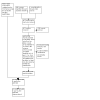


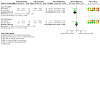
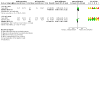
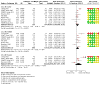
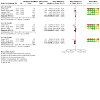
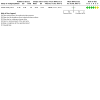
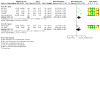
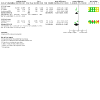
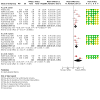
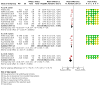
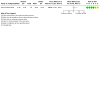

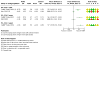
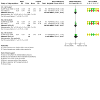
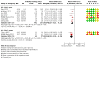
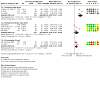
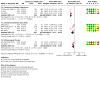

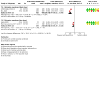
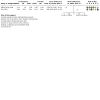
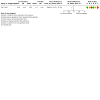
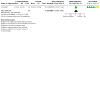
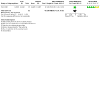
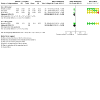
Comment in
-
Cochrane corner: interventions for myopia control in children.Eye (Lond). 2023 Dec;37(17):3526-3527. doi: 10.1038/s41433-023-02558-0. Epub 2023 May 4. Eye (Lond). 2023. PMID: 37142779 Free PMC article. No abstract available.
References
References to studies included in this review
Adler 2006 {published data only}
-
- Adler D, Millodot M. The possible effect of undercorrection on myopic progression in children. Clinical and Experimental Optometry 2006;89(5):315-21. - PubMed
Anstice 2011 {published data only}
-
- Anstice NS, Phillips JR. Effect of dual-focus soft contact lens wear on axial myopia progression in children. Ophthalmology 2011;118(6):1152-61. - PubMed
ATOM 2 Study 2012 {published data only}
-
- Chia A, Chua WH, Cheung YB, Wong WL, Lingham A, Fong A, et al. Atropine for the treatment of childhood myopia: safety and efficacy of 0.5%, 0.1%, and 0.01% doses (Atropine for the treatment of myopia 2). Ophthalmology 2012;119(2):347-54. - PubMed
-
- Chia A, Chua WH, Wen L, Fong A, Goon YY, Tan D. Atropine for the treatment of childhood myopia: changes after stopping atropine 0.01%, 0.1% and 0.5%. American Journal of Ophthalmology 2014;157(2):451-7. - PubMed
-
- Chia A, Li W, Tan D, Luu CD. Full-field electroretinogram findings in children in the Atropine treatment for myopia (ATOM2) study. Documenta Ophthalmologica. Advances in Ophthalmology 2013;126(3):177-86. - PubMed
-
- Chia A, Lu QS, Tan D. Five-year clinical trial on atropine for the treatment of myopia 2: myopia control with atropine 0.01% eyedrops. Ophthalmology 2016;123(2):391-9. - PubMed
-
- Chia A, Luu CD, Li W, Cheung YB, Tan D. Full-field electroretinogram findings in myopic children on topical atropine. Documenta Ophthalmologica. Advances in Ophthalmology 2011;123 Suppl 1:42. - PubMed
ATOM Study 2006 {published data only}
-
- Chia A, Chua WH, Tan D. Effect of topical atropine on astigmatism. British Journal of Ophthalmology 2009;93(6):799-802. - PubMed
-
- Chua W, Balakrishnan V, Chan Y. Analysis of safety data for atropine in the treatment of myopia (ATOM) study. Investigative Ophthalmology and Visual Science 2002;43(13):ARVO E-abstract 329.
-
- Chua W, Balakrishnan V, Tan D, Chan Y. Efficacy results from the atropine in the treatment of myopia (ATOM) study. Investigative Ophthalmology and Visual Science 2003;44(13):ARVO E-abstract 3119.
-
- Chua WH, Balakrishnan V, Chan YH, Tong L, Ling Y, Quah BL, et al. Atropine for the treatment of childhood myopia. Ophthalmology 2006;113(12):2285-91. - PubMed
-
- Chua WH, Tan D, Balakrishnan V, Chan YH, ATOM Study Group. Progression of childhood myopia following cessation of atropine treatment. Investigative Ophthalmology and Visual Science 2005;46(13):ARVO E-abstract 4625.
Bao 2021 {published data only}
-
- Bao J, Yang A, Huang Y, Li X, Yang A, Lim W, et al. One-year myopia control efficacy of spectacle lenses with aspherical lenslets. Investigative Ophthalmology and Visual Science 2021;62(8):2888.
Bian 2020 {published data only}
-
- Bian S, Liu H, Lin J. A randomized-controlled clinical study of one-year outcome between orthokeratology contact lens wear and glasses wear in myopic children. Chinese Journal of Experimental Ophthalmology 2020;38(2):121-7.
BLINK Study 2020 {published data only}
-
- Berntsen DA, Gostovic AT, Sinnott LT, Chandler MA, Huang J, Morrison A, et al. Peripheral defocus and axial eye growth in the bifocal lenses in nearsighted kids (BLINK) study. Investigative Ophthalmology and Visual Science 2021;62(8):ARVO E-abstract 2884.
Chamberlain 2019 {published data only}
-
- Chamberlain P, Arumugam B Jones D, Logan N, Peixoto-de-Matos S, Young G. Further comparison of myopia progression in new and established myopia control treatment (MiSight) groups. Contact Lens and Anterior Eye 2019;42(6 Suppl):e16.
-
- Chamberlain P, Bradley A, Arumugam B, Hammond, D, McNally J, Logan NS, et al. Long-term effect of dual-focus conact lenses on myopia progression in children: a 6-year multicentre clinical trial. Optometry and Vision Science 2022;99(3):204-12. - PubMed
-
- Chamberlain P, Hammond D, Arumugam B, Bullimore MA. Measured and predicted axial elongation in the MiSight 1 day clinical trial – 6 year results. Investigative Ophthalmology & Visual Science 2021;62(8):2342.
-
- Chamberlain P, Peixoto-de-Matos SC, Logan NS, Ngo C, Jones D, Young G. A 3-year randomized clinical trial of MiSight lenses for myopia control. Optometry and Vision Science 2019;96(8):556-67. - PubMed
-
- Flitcroft DI, Loughman J, Arumugam B, Bradley A, Chamberlain P. Centile-based analysis of refractive development in the MiSight® 1 day myopia control trial. Investigative Ophthalmology and Visual Science 2020;61(7):ARVO E-abstract 1372.
Charm 2013 {published data only}
-
- Charm J, Cho P. High myopia-partial reduction ortho-k: a 2-year randomized study. Optometry and Vision Science 2013;90(6):530-9. - PubMed
-
- Charm J, Cho P. High myopia-partial reduction orthokeratology (HM-PRO): study design. Contact Lens and Anterior Eye 2013;36(4):164-70. - PubMed
-
- Charm J, Cho P. High myopia-partial reduction orthokeratology (HM-PRO) study: recruitment and one year result. Contact Lens and Anterior Eye 2011;34:S3. - PubMed
Cheng 2010 {published data only}
-
- Cheng D, Schmid KL, Woo GC, Drobe B. Randomized trial of effect of bifocal and prismatic bifocal spectacles on myopic progression: two-year results. Archives of Ophthalmology 2010;128(1):12-9. - PubMed
-
- Cheng D, Woo GC, Drobe B, Schmid KL. Effect of bifocal and prismatic bifocal spectacles on myopia progression in children: three-year results of a randomized clinical trial. JAMA Ophthalmology 2014;132(3):258-64. - PubMed
Cheng 2016 {published data only}
-
- Cheng X, Xu J, Chehab K, Exford J, Brennan N. Soft contact lenses with positive spherical aberration for myopia control. Optometry and Vision Science 2016;93(4):353-66. - PubMed
Chung 2002 {published data only}
-
- Chung K, Mohidin N, O'Leary DJ. Undercorrection of myopia enhances rather than inhibits myopia progression. Vision Research 2002;42(22):2555-9. - PubMed
CLAMP Study 2004 {published data only}
-
- Walline JJ, Jones LA, Mutti DO, Zadnik K. A randomized trial of the effects of rigid contact lenses on myopia progression. Archives of Ophthalmology 2004;122(12):1760-6. - PubMed
-
- Walline JJ, Jones LA, Mutti DO, Zadnik K. The contact lens and myopia progression (CLAMP) study. Ophthalmic and Physiological Optics 2006;26:29.
-
- Walline JJ, Jones LA, Mutti DO, Zadnik K. Use of a run-in period to decrease loss to follow-up in the Contact lens and myopia progression (CLAMP) study. Controlled Clinical Trials 2003;24(6):711-8. - PubMed
-
- Walline JJ, Mutti DO, Jones LA, Rah MJ, Nichols KK, Watson R, et al. The contact lens and myopia progression (CLAMP) study: design and baseline data. Optometry and Vision Science 2001;78(4):223-33. - PubMed
COMET2 Study 2011 {published data only}
-
- Correction of Myopia Evaluation Trial 2 Study Group for the Pediatric Eye Disease Investigator Group. Progressive-addition lenses versus single-vision lenses for slowing progression of myopia in children with high accommodative lag and near esophoria. Investigative Ophthalmology and Visual Science 2011;52(5):2749-57. - PMC - PubMed
COMET Study 2003 {published data only}
-
- Comet Study Group. The design of the Correction of Myopia Evaluation Trial. In: American Academy of Optometry. 1997:130.
-
- Deng L, Manny R, Crossnoe C, Gwiazda J. Longitudinal measures of intraocular pressure and axial length in a subgroup of children in the Correction of Myopia Evaluation Trial (COMET). Investigative Ophthalmology and Visual Science 2007;48(13):ARVO E-abstract 4829.
-
- Dias L, Hyman L, Manny RE, Fern K, COMET Group. Evaluating the self-esteem of myopic children over a three-year period: the COMET experience. Optometry and Vision Science 2005;82(4):338-47. - PubMed
-
- Dias L, Manny R, Hyman L, Fern K, COMET Group. Ocular factors and self perception in myopic children. Investigative Ophthalmology and Visual Science 2001;42(13):ARVO E-abstract 2101.
CONTROL Study 2016 {published data only}
-
- Aller TA, Liu M, Wildsoet CF. Myopia control with bifocal contact lenses: a randomized clinical trial. Optometry and Vision Science 2016;93(4):344-52. - PubMed
-
- Aller TA, Wildsoet C. Results of a one-year prospective clinical trial (CONTROL) of the use of bifocal soft contact lenses to control myopia progression. Ophthalmic and Physiological Optics 2006;26 Suppl 1:8-9.
-
- Aller TA. Design of a prospective clinical trial of the use of bifocal soft contact lenses to control myopia progression (CONTROL). In: 10th International Myopia Conference. 2004.
Cui 2021 {published data only}
-
- Qin J, Lyu Y, Wei L, Zhang J, Zhao B, Fu A. Comparison of myopia progression between different concentrations and application frequencies of atropine eye drops in children. Chinese Journal of Experimental Ophthalmology 2021;39(5):423-9.
DISC Study 2011 {published data only}
-
- Lam CS, Tang WC, Tang YY. Randomised clinical trial of myopia control in myopic schoolchildren using the defocus incorporated soft contact (DISC) lens. Optometry and Vision Science 2011;88(3):444-5.
Edwards 2002 {published data only}
-
- Edwards MH, Li RW, Lam CS, Lew JK, Yu BS. The Hong Kong progressive lens myopia control study: study design and main findings. Investigative Ophthalmology and Visual Science 2002;43(9):2852-8. - PubMed
Fujikado 2014 {published data only}
Fulk 1996 {published data only}
-
- Fulk GW, Cyert LA. Can bifocals slow myopia progression? Journal of the American Optometric Association 1996;67(12):749-54. - PubMed
Fulk 2002 {published data only}
-
- Fulk GW, Cyert LA, Parker DE, West RW. The effect of changing from glasses to soft contact lenses on myopia progression in adolescents. Ophthalmic and Physiological Optics 2003;23(1):71-7. - PubMed
-
- Fulk GW, Cyert LA, Parker DE. A 3-year clinical trial of bifocals in children with near point esophoria: myopia progression during the first year. Investigative Ophthalmology and Visual Science 1998;39:S2982.
-
- Fulk GW, Cyert LA, Parker DE. A 3-year clinical trial of bifocals to slow myopia progression in children with near-point esophoria: baseline characteristics. Investigative Ophthalmology and Visual Science 1997;38:S5404.
-
- Fulk GW, Cyert LA, Parker DE. A clinical trial of bifocals in children: myopia progression after two years. Investigative Ophthalmology and Visual Science 1999;40:S3665.
-
- Fulk GW, Cyert LA, Parker DE. A randomized clinical trial of bifocal glasses for myopic children with esophoria: results after 54 months. Optometry 2002;73(8):470-6. - PubMed
Garcia‐del Valle 2021 {published data only}
-
- Garcia-Del Valle AM, Blázquez V, Gros-Otero J, Infante M, Culebras A, Verdejo A, et al. Efficacy and safety of a soft contact lens to control myopia progression. Clinical and Experimental Optometry 2021;104(1):14-21. - PubMed
Guo 2021 {published data only}
Han 2018 {published data only}
-
- Han X, Xu D, Ge W, Wang Z, Li X, Liu W. A comparison of the effects of orthokeratology lens, Medcall lens, and ordinary frame glasses on the accommodative response in myopic children. Eye and Contact Lens 2018;44(4):268-71. - PubMed
Han 2019 {published data only}
-
- Han WT, Rong A, Xu W. Combination with different anticholinergic eyedrops for the treatment of children myopia. National Medical Journal of China 2019;99(24):1859-63. - PubMed
Hasebe 2008 {published data only}28611140
-
- Fujiwara M, Hasebe S, Nakanishi R, Tanigawa K, Ohtsuki H. Seasonal variation in myopia progression and axial elongation: an evaluation of Japanese children participating in a myopia control trial. Japanese Journal of Ophthalmology 2012;56(4):401-6. - PubMed
-
- Hasebe S, Nakatsuka C, Hamasaki I, Ohtsuki H. Downward deviation of progressive addition lenses in a myopia control trial. Ophthalmic and Physiological Optics 2005;25(4):310-4. - PubMed
-
- Hasebe S, Nonaka F, Nakatsuka C, Ohtsuki H. Myopia control trial with progressive addition lenses in Japanese schoolchildren: baseline measures of refraction, accommodation, and heterophoria. Japanese Journal of Ophthalmology 2005;49(1):23-30. - PubMed
-
- Hasebe S, Ohtsuki H, Nonaka T, Nakatsuka C, Miyata M, Hamasaki I, et al. Effect of progressive addition lenses on myopia progression in Japanese children: a prospective, randomized, double-masked, crossover trial. Investigative Ophthalmology and Visual Science 2008;49(7):2781-9. - PubMed
-
- Hasebe S. A clinical trial to evaluate progressive addition lenses on myopia control. Study design. Japanese Journal of Vision Science 2002;23:63-8.
Hasebe 2014 {published data only}
-
- Hasebe S, Jun J, Varnas SR. Myopia control with positively aspherized progressive addition lenses: a 2-year, multicenter, randomized, controlled trial. Investigative Ophthalmology and Visual Science 2014;55(11):7177-88. - PubMed
Hieda 2021 {published data only}
-
- Hieda O, Hiraoka T, Fujikado T, Ishiko S, Hasebe S, Torii H, et al. Efficacy and safety of 0.01% atropine for prevention of childhood myopia in a 2-year randomized placebo-controlled study. Japanese Journal of Ophthalmology 2021;65(3):315-25. - PubMed
Houston Study 1987 {published data only}
-
- Grosvenor T, Maslovitz B, Perrigin DM, Perrigin J. The Houston Myopia Control Study: a preliminary report by the patient care team. Journal of the American Optometric Association 1985;56(8):636-43. - PubMed
-
- Grosvenor T, Perrigin DM, Perrigin J, Maslovitz B. Houston Myopia Control Study: a randomized clinical trial. Part II. Final report by the patient care team. American Journal of Optometry and Physiological Optics 1987;64(7):482-98. - PubMed
-
- Young FA, Leary GA, Grosvenor T, Maslovitz B, Perrigin DM, Perrigin J, et al. Houston Myopia Control Study: a randomized clinical trial. Part I. Background and design of the study. American Journal of Optometry and Physiological Optics 1985;62(9):605-13. - PubMed
Jakobsen 2022 {published data only}
-
- Jakobsen TM, Moller F. Control of myopia using orthokeratology lenses in Scandinavian children aged 6 to 12 years. Eighteen-month data from the Danish randomized study: Clinical Study of Near-sightedness; Treatment with Orthokeratology Lenses (CONTROL study). Acta Ophthalmologica 2022;100(2):175-82. - PMC - PubMed
Jensen 1991 {published data only}
-
- Jensen H. Myopia progression in young school children. A prospective study of myopia progression and the effect of a trial with bifocal lenses and beta blocker eye drops. Acta Ophthalmologica 1991;200(Suppl):1-79. - PubMed
-
- Jensen H. Timolol maleate in the control of myopia. A preliminary report. Acta Ophthalmologica 1988;185(Suppl):128-9. - PubMed
Katz 2003 {published data only}
-
- Chew SJ, Saw SM, Rajan U, Lau C, O'Brien L, Chan TK, et al. RGP contact lenses in the control of myopia progression. Investigative Ophthalmology and Visual Science 1997;38:S5402.
-
- Katz J, Schein OD, Levy B, Cruiscullo T, Saw SM, Rajan U, et al. A randomized trial of rigid gas permeable contact lenses to reduce progression of children's myopia. American Journal of Ophthalmology 2003;136(1):82-90. - PubMed
Kinoshita 2020 {published data only}
Koomson 2016 {published data only}
-
- Koomson NY, Amedo AO, Opoku-Baah C, Ampeh PB, Ankamah E, Bonsu K. Relationship between reduced accommodative lag and myopia progression. Optometry and Vision Science 2016;93(7):683-91. - PubMed
Lam 2020 {published data only}
LAMP Study 2019 {published data only}
-
- Li FF, Kam KW, Zhang Y, Tang SM, Young AL, Chen LJ, et al. Differential effects on ocular biometrics by 0.05%, 0.025%, and 0.01% atropine: Low-concentration Atropine for Myopia Progression study. Ophthalmology 2020;127(12):1603-11. - PubMed
-
- Li FF, Tang SM, Kam KW, Chen LJ, Yam J. Effect of 0.05%, 0.025%, and 0.01% atropine eye drops on corneal parameters over one year: Low-concentration Atropine for Myopia Progression (LAMP) study. Investigative Ophthalmology and Visual Science 2019;60(9):ARVO E-abstract 4336.
-
- Li FF, Zhang Y, Zhang X, Yip BH, Tang SM, Kam KW, et al. Age effect on treatment responses to 0.05%, 0.025%, and 0.01% atropine: Low-concentration Atropine for Myopia Progression study. Ophthalmology 2021;128(8):1180-7. - PubMed
-
- Yam J, Li, FF, Tang SM, Chen LJ, Tham CC. Low-concentration Atropine for Myopia Progression (LAMP) study phase 2: 0.05% atropine remained the best concentration among 0.05%, 0.025%, and 0.01% atropine over 2 years. Investigative Ophthalmology and Visual Science 2019;60(9):ARVO E-abstract 4814.
-
- Yam JC, Jiang Y, Lee J, Li S, Zhang Y, Sun W, et al. The association of choroidal thickening by atropine with treatment effects for myopia: two-year clinical trial of the LAMP study. American Journal of Ophthalmology . 2022;237:130-8. - PubMed
Lu 2015 {published data only}
-
- Lu YM, Ma SS, Luo M, Liang N. Clinical effect of the midperiphery additional designed lenses combined adjustment training on myopia in childhood. International Eye Science 2015;15(11):1960-3.
Lyu 2020 {published data only}
-
- Lyu T, Wang L, Zhou L, Qin J, Ma H, Shi M. Regimen study of high myopia-partial reduction orthokeratology. Eye and Contact Lens 2020;46(3):141-6. - PubMed
MIT Study 2001 {published data only}
-
- Hsiao CK, Chen CJ, Shih YF, Lin LL, Hung PT, Yao CL, et al. Design and statistical analysis for the Myopia Intervention Trial in Taiwan. In: Lin LLK, Shih YF, Hung PT , editors(s). Myopia Updates II, 7th International Conference on Myopia, Taipei, Taiwan, Nov-Dec, 1998. Springer-Verlag, 2000:161-4.
-
- Hsiao CK, Tsai MY, Chen HM. Inference of nested variance components in a longitudinal myopia intervention trial. Statistics in Medicine 2005;24(21):3251-67. - PubMed
-
- Shih YF, Hsiao CK, Chen CJ, Chang CW, Hung PT, Lin LL. An intervention trial on efficacy of atropine and multi-focal glasses in controlling myopic progression. Acta Ophthalmologica Scandinavica 2001;79(3):233-6. - PubMed
Moriche‐Carretero 2021 {published data only}
-
- Moriche-Carretero M, Revilla-Amores R, Diaz-Valle D, Morales-Fernández L, Gomez-de-Liaño, R. Myopia progression and axial elongation in Spanish children: efficacy of atropine 0.01% eye-drops. Journal Francais d'Ophtalmologie 2021;44(10):1499-504. - PubMed
Pärssinen 1989 {published data only}
-
- Hemminki E, Pärssinen O. Prevention of myopic progress by glasses. Study design and the first-year results of a randomized trial among schoolchildren. American Journal of Optometry and Physiological Optics 1987;64(8):611-6. - PubMed
-
- Pärssinen O, Hemminki E. Spectacle-use, bifocals and prevention of myopic progression. The two-years results of a randomized trial among schoolchildren. Acta Ophthalmologica 1988;185(Suppl):156-61. - PubMed
-
- Pärssinen O, Kauppinen M, Viljanen A. Astigmatism among myopics and its changes from childhood to adult age: a 23-year follow-up study. Acta Ophthalmologica 2015;93(3):276-83. - PubMed
-
- Pärssinen O, Kauppinen M, Viljanen A. The progression of myopia from its onset at age 8-12 to adulthood and the influence of heredity and external factors on myopic progression. A 23-year follow-up study. Acta Ophthalmologica 2014;92(8):730-9. - PubMed
PIR‐205 Study 2004 {published data only}
-
- Bartlett JD, Niemann K, Houde B, Allred T, Edmondson MJ, Crockett RS. A tolerability study of pirenzepine ophthalmic gel in myopic children. Journal of Ocular Pharmacology and Therapeutics 2003;19(3):271-9. - PubMed
-
- Bartlett JD, Niemann K, Houde B, Allred T, Edmondson MJ. Safety and tolerability of pirenzepine ophthalmic gel in pediatric, myopic patients. Investigative Ophthalmology and Visual Science 2000;41(13):ARVO E-abstract 1598.
-
- Bartlett JD, Voce M, Than TP, Edmondson M, Novack GD. Electronic monitoring system to assess patient adherence in pediatric drug studies. Investigative Ophthalmology and Visual Science 2003;44(13):ARVO E-abstract 1930.
-
- Chu R, Cotter S, Kwon S, PIR-205 Investigator Group. Pirenzepine 2% ophthalmic gel retards myopia progression in 8-12 year old children. In: American Academy of Optometry. 2003:170.
-
- Cotter SA, Chu RH, Kwon S. Pirenzepine 2% ophthalmic gel retards myopia progression in 8- to 12-year-old children. Optometry 2003;74:382-3.
Ren 2017 {published data only}
-
- Ren QJ, Yue H, Wang P, Liu RJ, Lu P. Effects of low concentration atropine and orthokeratology on myopia prevention and control. International Eye Science 2017;17(4):794-6.
ROMIO Study 2012 {published data only}
-
- Chan KY, Cheung SW, Cho P. Clinical performance of an orthokeratology lens fitted with the aid of a computer software in Chinese children. Contact Lens and Anterior Eye 2012;35(4):180-4. - PubMed
-
- Cheung SW, Cho P. Long-term effect of orthokeratology on the anterior segment length. Contact Lens and Anterior Eye 2016;39(4):262-5. - PubMed
-
- Cheung SW, Cho P. Validity of axial length measurements for monitoring myopic progression in orthokeratology. Investigative Ophthalmology and Visual Science 2013;54(3):1613-5. - PubMed
-
- Cho P, Cheung SW. Orthokeratology for slowing myopic progression: a randomised controlled trial. Contact Lens and Anterior Eye 2011;34:S2-3. - PubMed
-
- Cho P, Cheung SW. Protective role of orthokeratology in reducing risk of rapid axial elongation: a reanalysis of data from the ROMIO and TO-SEE studies. Investigative Ophthalmology and Visual Science 2017;58(3):1411-6. - PubMed
Ruiz‐Pomeda 2018 {published data only}
-
- Ruiz-Pomeda A, Fernandes P, Amorim-de-Sousa A, González-Méijome JM, Prieto-Garrido FL, Pérez-Sánchez B, et al. Light disturbance analysis in the controlled randomized clinical trial MiSight® Assessment Study Spain (MASS). Contact Lens and Anterior Eye 2019;42(2):200-5. - PubMed
-
- Ruiz-Pomeda A, Pérez-Sánchez B, Cañadas P, Prieto-Garrido FL, Gutiérrez-Ortega R, Villa-Collar C. Binocular and accommodative function in the controlled randomized clinical trial MiSight Assessment Study Spain (MASS). Graefes Archives of Clinical and Experimental Ophthalmology 2018;257(1):207-15. - PubMed
-
- Ruiz-Pomeda A, Pérez-Sánchez B, Prieto-Garrido FL, Gutiérrez-Ortega R, Villa-Collar C. MiSight assessment study Spain: adverse events, tear film osmolarity, and discontinuations. Eye and Contact Lens 2018;44 Suppl 2:S180-6. - PubMed
-
- Ruiz-Pomeda A, Pérez-Sánchez B, Valls I, Prieto-Garrido FL, Gutiérrez-Ortega R, Villa-Collar C. MiSight Assessment Study Spain (MASS). A 2-year randomized clinical trial. Graefes Archives of Clinical and Experimental Ophthalmology 2018;256(5):1011-21. - PubMed
Sankaridurg 2010 {published data only}
-
- Sankaridurg P, Holden B, Smith E, Naduvilath T, Chen X, Jara PL, et al. Decrease in rate of myopia progression with a contact lens designed to reduce relative peripheral hyperopia: one-year results. Investigative Ophthalmology and Visual Science 2011;52(13):9362-7. - PubMed
Sankaridurg 2019 {published data only}
-
- Sankaridurg P, Bakaraju RC, Naduvilath T, Chen X, Weng R, Tilia D, et al. Myopia control with novel central and peripheral plus contact lenses and extended depth of focus contact lenses: 2 year results from a randomised clinical trial. Ophthalmic and Physiological Optics 2019;39(4):294-307. - PMC - PubMed
Schwartz 1981 {published data only}
-
- Schwartz JT. A monozygotic cotwin control study of a treatment for myopia. Acta Geneticae Medicae et Gemellologiae 1974;23(spec. nr.):26. - PubMed
-
- Schwartz JT. A monozygotic co-twin control study of a treatment for myopia. Acta Geneticae Medicae et Gemellologiae 1976;25:133-6. - PubMed
-
- Schwartz JT. Results of a monozygotic co-twin control study on a treatment for myopia. Acta Geneticae Medicae et Gemellologiae 1980;29(1):30. - PubMed
-
- Schwartz JT. Results of a monozygotic co-twin control study on a treatment for myopia. Progress in Clinical and Biological Research 1981;Pt C:249-58. - PubMed
Shih 1999 {published data only}
-
- Chen CH, Shih YF, Chou AC, Ho TC, Lin LL, Hung PT. The effect of different concentrations of atropine on myopia controlling in myopic children. Investigative Ophthalmology and Visual Science 1997;38:S4537.
-
- Shih YF, Chen CH, Chou AC, Ho TC, Lin LL, Hung PT. Effects of different concentrations of atropine on controlling myopia in myopic children. Journal of Ocular Pharmacology and Therapeutics 1999;15(1):85-90. - PubMed
STAMP Study 2012 {published data only}
-
- Berntsen D, Mutti D, Zadnik K. The effect of bifocal add, correction type, and adaptation on accommodative lag in myopic children. In: American Academy of Optometry. 2009.
Swarbrick 2015 {published data only}
-
- Swarbrick HA, Alharbi A, Lum E, Watt K. Overnight orthokeratology for myopia control: short-term effects on axial length and refractive error. Contact Lens and Anterior Eye 2011;34:S3.
-
- Swarbrick HA, Alharbi A, Watt K, Lum E, Kang P. Myopia control during orthokeratology lens wear in children using a novel study design. Ophthalmology 2015;122(3):620-30. - PubMed
Tan 2005 {published data only}
-
- Tan D, Chia A, Han CW, Bun CY. Author reply: one-year multicenter, double-masked, placebo-controlled, parallel safety and efficacy study of 2% pirenzepine ophthalmic gel in children with myopia. Ophthalmology 2012;119(12):2653-4. - PubMed
-
- Tan DT, Lam D, Chua WH, Crockett RS. Pirenzepine ophthalmic gel (PIR): safety and efficacy for pediatric myopia in a one-year study in Asia. Investigative Ophthalmology and Visual Science 2003;44(13):ARVO E-abstract 801.
-
- Tan DT, Lam DS, Chua WH, Shu-Ping DF, Crockett RS, Asian Pirenzepine Study Group. One-year multicenter, double-masked, placebo-controlled, parallel safety and efficacy study of 2% pirenzepine ophthalmic gel in children with myopia. Ophthalmology 2005;112(1):84-91. - PubMed
Tan 2020 {published data only}
-
- Tan Q, Ng AL, Choy BN, Cheng GP, Woo VC, Cho P. One-year results of 0.01% atropine with orthokeratology (AOK) study: a randomised clinical trial. Ophthalmic and Physiological Optics 2020;40(5):557-66. - PubMed
Tang 2021 {published data only}
-
- Tang WT, Li JQ, Zhou LS, Yu Q. Effect of orthokeratology on relative peripheral refraction in adolescent myopia. International Eye Science 2021;21(4):734-7.
Trier 2008 {published data only}
-
- Trier K, Ribel-Madsen SM. Effect of 7-methylxanthine on axial eye growth in myopic children—24 months follow-up. Investigative Ophthalmology and Visual Science 2007;48(13):ARVO E-abstract 4421.
-
- Trier K, Ribel-Madsen SM. Effect of 7-methylxanthine on eye growth in myopic children—36 months follow-up. Investigative Ophthalmology and Visual Science 2008;49(13):ARVO E-abstract 2609.
Wang 2017 {published data only}
Wei 2020 {published data only}
Yang 2009 {published data only}
-
- Lan W, Yang Z, Ge J, Liu W, Chen X. The effectiveness of progressive additional lens on Chinese juvenile-onset acquired myopia: the first year report. Ophthalmic and Physiological Optics 2006;26:8.
-
- Yang Z, Lan W, Ge J, Liu W, Chen X, Chen L, et al. The effectiveness of progressive addition lenses on the progression of myopia in Chinese children. Ophthalmic and Physiological Optics 2009;29(1):41-8. - PubMed
Yen 1989 {published data only}
-
- Yen MY, Liu JH, Kao SC, Shiao CH. Comparison of the effect of atropine and cyclopentolate on myopia. Annals of Ophthalmology 1989;21(5):180-2. - PubMed
Yi 2015 {published data only}
-
- Yi S, Huang Y, Yu SZ, Chen XJ, Yi H, Zeng XL. Therapeutic effect of atropine 1% in children with low myopia. Journal of AAPOS 2015;19(5):426-9. - PubMed
Zhang 2021 {published data only}
Zhao 2021 {published data only}
-
- Zhao Q, Hao Q. Clinical efficacy of 0.01% atropine in retarding the progression of myopia in children. Ophthalmic Epidemiology 2021;28(5):376-82. - PubMed
-
- Zhao Q, Hao Q. Comparison of the clinical efficacies of 0.01% atropine and orthokeratology in controlling the progression of myopia in children. Ophthalmic Epidemiology 2021;28(5):376-82. - PubMed
References to studies excluded from this review
Abraham 1966 {published data only}
-
- Abraham SV. Control of myopia with tropicamide. Journal of Pediatric Ophthalmology 1966;3:10-22.
ACHIEVE Study 2008 {published data only}
-
- Jones-Jordan LA, Chitkara M, Coffey B, Jackson JM, Manny RE, Rah MJ, et al. A comparison of spectacle and contact lens wearing times in the ACHIEVE study. Clinical and Experimental Optometry 2010;93(3):157-63. - PubMed
-
- Rah MJ, Walline JJ, Jones-Jordan LA, Sinnott LT, Jackson JM, ACHIEVE Study Group. Vision specific quality of life of pediatric contact lens wearers. Optometry and Vision Science 2010;87(8):560-6. - PubMed
-
- Walline JJ, Jones LA, Chitkara M, Coffey B, Jackson JM, ACHIEVE Study Group. The Adolescent and Child Health Initiative to Encourage Vision Empowerment (ACHIEVE) study. In: American Academy of Optometry. 2004. - PubMed
-
- Walline JJ, Jones LA, Chitkara M, Coffey B, Jackson JM, ACHIEVE Study Group. The Adolescent and Child Health Initiative to Encourage Vision Empowerment (ACHIEVE) study design and baseline data. Optometry and Vision Science 2006;83(1):37-45. - PubMed
-
- Walline JJ, Jones LA, Sinnott L, Chitkara M, Coffey B, Jackson JM, et al. Soft contact lenses do not increase myopia progression in children. Investigative Ophthalmology and Visual Science 2008;49(13):ARVO E-abstract 2021. - PubMed
ACTRN12620000159954 {published data only}
-
- ACTRN12620000159954. MALCOLM - MultifocAL COntact Lenses for Myopia. trialsearch.who.int/Trial2.aspx?TrialID=ACTRN12620000159954 (date of registration 13 February 2020).
ACTRN12620001046998 {published data only}
-
- ACTRN12620001046998. Effect of adding atropine to orthokeratology on eye elongation and myopia progression in children. trialsearch.who.int/Trial2.aspx?TrialID=ACTRN12620001046998 (date of registration 15 October 2020).
Aller 2008 {published data only}
-
- Aller TA, Wildsoet C. Bifocal soft contact lenses as a possible myopia control treatment: a case report involving identical twins. Clinical and Experimental Optometry 2008;91(4):394-9. - PubMed
Anderson 2016 {published and unpublished data}
-
- Anderson HA, Benoit J, Manny RE. Evaluation of progressive addition lens wear and age-related changes in phoria magnitude in myopic children. Investigative Ophthalmology and Visual Science 2016;57(12):ARVO E-abstract 1523.
Andreo 1990 {published data only}
-
- Andreo LK. Long-term effects of hydrophilic contact lenses on myopia. Annals of Ophthalmology 1990;22(6):224-7. - PubMed
Avetisov 2019 {published data only}
-
- Avetisov SE, Myagkov AV, Egorova AV. Correcting progressive myopia with bifocal contact lenses with central zone for distant vision: changes in accommodation and axial length (a preliminary report). Vestnik Oftalmologii 2019;135(1):42-6. - PubMed
Bakaraju 2015 {published and unpublished data}
-
- Bakaraju RC, Xu P, Song S, Ma M, Chen X, Jong M, et al. Extended depth-of-focus contact lenses can slow the rate of progression of myopia. Investigative Ophthalmology and Visual Science 2015;56:ARVO E-abstract 1728.
Baldwin 1969 {published data only}
-
- Baldwin WR, West D, Jolley J, Reid W. Effects of contact lenses on refractive corneal and axial length changes in young myopes. American Journal of Optometry and Archives of American Academy of Optometry 1969;46(12):903-11. - PubMed
Baltimore Myopia Project 1946 {published data only}
-
- Betts AE. An evaluation of the Baltimore Myopia Control Project part A. Experimental procedures. Journal of the American Optometric Association 1947;18:481-5.
-
- Ewalt HW Jr. The Baltimore Myopia Control Project. Journal of the American Optometric Association 1946;17:167-85.
Baronet 1979 {published data only}
-
- Baronet, Lecaillon-Thiobon. Longitudinal study of developing myopia and effects of treatment with atropine and Difrarel E [Étude longitudinale des myopies évolutives et effets du traitement par atropine et Difrarel E]. Bulletin des Societes d Ophtalmologie de France 1979;79(4-5):417-21. - PubMed
Bedrossian 1979 {published data only}
-
- Bedrossian RH. The effect of atropine on myopia. Annals of Ophthalmology 1971;3(8):891-7. - PubMed
-
- Bedrossian RH. The effect of atropine on myopia. Ophthalmology 1979;86(5):713-9. - PubMed
-
- Bedrossian RH. Treatment of progressive myopia with atropine. In: Weigelin E , editors(s). XX Concilium Ophthalmologicum Germania, International Congress Series No. 146. Amsterdam: Excerpta Medica Foundation, 1966:612-7.
Berkeley OK Study 1983 {published data only}
-
- Brand RJ, Polse KA, Schwalbe JS. The Berkeley Orthokeratology Study, Part I. General conduct of the study. American Journal of Optometry and Physiological Optics 1983;60(3):175-86. - PubMed
-
- Polse KA, Brand RJ, Keener RJ, Schwalbe JS, Vastine DW. The Berkeley Orthokeratology Study, Part III. Safety. American Journal of Optometry and Physiological Optics 1983;60(4):321-8. - PubMed
-
- Polse KA, Brand RJ, Schwalbe JS, Vastine DW, Keener RJ. The Berkeley Orthokeratology Study, Part II. Efficacy and duration. American Journal of Optometry and Physiological Optics 1983;60(3):187-98. - PubMed
-
- Polse KA, Brand RJ, Vastine DW, Schwalbe JS. Corneal change accompanying orthokeratology. Plastic or elastic? Results of a randomized controlled clinical trial. Archives of Ophthalmology 1983;101(12):1873-8. - PubMed
-
- Polse KA, Brand RJ. Contact lens effects on ametropia: a current example of the clinical trial. American Journal of Optometry and Physiological Optics 1981;58(4):281-8. - PubMed
Bier 1988 {published data only}
-
- Bier N, Lowther G. Myopia Control Study: effect of different contact lens refractive corrections on the progression of myopia. Optometry Today 1988;28:38-40.
Brodstein 1984 {published data only}
-
- Brodstein RS, Brodstein DE, Olson RJ, Hunt SC, Williams RR. The treatment of myopia with atropine and bifocals: a long-term prospective study. Ophthalmology 1984;91(11):1373-9. - PubMed
Cambridge Anti‐Myopia Study 2013 {published data only}
-
- Allen PM, Radhakrishnan H, Price H, Rae S, Theagarayan B, Calver RI, et al. A randomised clinical trial to assess the effect of a dual treatment on myopia progression: the Cambridge Anti-Myopia Study. Ophthalmic and Physiological Optics 2013;33(3):267-76. - PubMed
-
- Price H, Allen PM, Radhakrishnan H, Calver R, Rae S, Theagarayan B, et al. The Cambridge Anti-myopia Study: variables associated with myopia progression. Optometry and Vision Science 2013;90(11):1274-83. - PubMed
Chan 2014 {published data only}
-
- Chan KY, Cheung SW, Cho P. Orthokeratology for slowing myopic progression in a pair of identical twins. Contact Lens and Anterior Eye 2014;37(2):116-9. - PubMed
Chan 2020 {published data only}
-
- Chan HL, Yu WY, Li SZ, Choi KY, Chan J, Choy BN, et al. Changes of refractive errors in children with different initial predicted myopia progression rates after 6-month 0.01% atropine treatment. Investigative Ophthalmology and Visual Science 2020;61(7):ARVO E-abstract.
Chen 2012 {published data only}
-
- Chen Z, Niu LL, Xue F, Qu XM, Zhou ZM, Zhou XT, et al. Impact of pupil diameter on axial growth in orthokeratology. Optometry and Vision Science 2012;89(11):1636-40. - PubMed
Chen 2014 {published data only}
-
- Chen YH. Clinical observation of the development of juvenile myopia wearing glasses with full correction and under-correction. International Eye Science 2014;14(8):1553-4.
Chen 2016 {published data only}
-
- Chen Z, Xue F, Zhou J, Qu X, Zhou X. Effects of orthokeratology on choroidal thickness and axial length. Optometry and Vision Science 2016;93(9):1064-71. - PubMed
Cheung 2018 {published data only}
-
- Cheung SW, Cho P. Does a two-year period of orthokeratology lead to changes in the endothelial morphology of children? Contact Lens and Anterior Eye 2018;41(2):214-8. - PubMed
ChiCTR2000034760 {published data only}
-
- ChiCTR2000034760. A randomized cross-over controlled study on prevention of myopia in children with 0.01% atropine eye drops. trialsearch.who.int/Trial2.aspx?TrialID=ChiCTR2000034760 (date of registration 18 July 2020).
ChiCTR2000038078 {published data only}
-
- ChiCTR2000038078. Efficacy of artificial natural light in myopia control of school-aged children. trialsearch.who.int/Trial2.aspx?TrialID=ChiCTR2000038078 (date of registration 9 September 2020).
ChiCTR2100052322 {published data only}
-
- ChiCTR2100052322. Myopia control effect of repeated low-level red-light therapy in Chinese children: a randomized, double-blind, placebo-controlled clinical trial. trialsearch.who.int/Trial2.aspx?TrialID=ChiCTR2100052322 (date of registration 24 October 2021).
ChiCTR‐IOC‐17010525 {published data only}
-
- ChiCTR-IOC-17010525. Effect of health education on time outdoors in school-aged children: a randomized controlled trial. trialsearch.who.int/Trial2.aspx?TrialID=ChiCTR-IOC-17010525 (date of registration 26 January 2017).
ChiCTR‐OON‐17010470 {published data only}
-
- ChiCTR-OON-17010470. Investigation on correction of myopia in primary and middle school students. https://trialsearch.who.int/Trial2.aspx?TrialID=ChiCTR-OON-17010470 (date of registration 19 January 2017).
ChiCTR‐TRC‐070000297 {published data only}
-
- ChiCTR-TRC-07000029. Double-blinded, randomized controlled trial about the influence of new lenses on the progress of children's myopia. trialsearch.who.int/Trial2.aspx?TrialID=ChiCTR-TRC-07000029 (date of registration 30 November 2007).
Cho 2012 {published data only}
-
- Cho P, Chan B, Cheung SW, Mountford J. Do fenestrations affect the performance of orthokeratology lenses? Optometry and Vision Science 2012;89(4):401-10. - PubMed
Cho 2017 {published data only}
-
- Cho P, Cheung SW. Discontinuation of orthokeratology on eyeball elongation (DOEE). Contact Lens and Anterior Eye 2017;40(2):82-7. - PubMed
Choi 2005 {published data only}
-
- Choi YY, Jeong JW, Park DJ. Effect of 1% atropine with tinted bifocal glasses in slowing the progression of myopia in children. In: American Academy of Ophthalmology. 2005:234.
Chou 1997 {published data only}
-
- Chou AC, Shih YF, Ho TC, Lin LL. The effectiveness of 0.5% atropine in controlling high myopia in children. Journal of Ocular Pharmacology and Therapeutics 1997;13(1):61-7. - PubMed
Diaz‐Llopis 2018 {published and unpublished data}
-
- Diaz-Llopis M, Pinazo-Duran MD. Superdiluted atropine at 0.01% reduces progression in children and adolescents. A 5 year study of safety and effectiveness. Archivos de la Sociedad Espanola de Oftalmologia 2018;93:182-5. - PubMed
Dumbleton 1999 {published data only}
-
- Dumbleton KA, Chalmers RL, Richter DB, Fonn D. Changes in myopic refractive error with nine months' extended wear of hydrogel lenses with high and low oxygen permeability. Optometry and Vision Science 1999;76(12):845-9. - PubMed
-
- Dumbleton KA, Richter D, Fonn D, Chalmers R. Refractive and keratometric changes following extended wear. In: American Academy of Optometry. 1998:170.
Dyer 1979 {published data only}
-
- Dyer JA. Role of cycloplegics in progressive myopia. Ophthalmology 1979;86(5):692-4. - PubMed
Ebri 2007 {published data only}
-
- Ebri A, Kuper H, Wedner S. Cost-effectiveness of cycloplegic agents: results of a randomized controlled trial in Nigerian children. Investigative Ophthalmology and Visual Science 2007;48(3):1025-31. - PubMed
Eissa 2018 {published data only}
-
- Eissa S, Badr Eldin N. ICL versus SMILE in management of anisometropic myopic amblyopia in children. Canadian Journal of Ophthalmology 2018;53:560-7. - PubMed
Filip 2000 {published data only}
-
- Filip M, Stefaniu I, Stefan C. Changes in myopic refractive errors after 9 months of extensive wear of hydrogel lenses with high oxygen permeability and compared with those with low permeability. Oftalmologia 2000;51(2):35-40. - PubMed
French 2016 {published data only}
-
- French, AN. Increasing children's time spent outdoors reduces the incidence of myopia. Evidence-Based Medicine 2016;21(2):76. - PubMed
Gimbel 1973 {published data only}
-
- Gimbel HV. The control of myopia with atropine. Canadian Journal of Ophthalmology 1973;8(4):527-32. - PubMed
Goss 1984 {published data only}
-
- Goss DA. Overcorrection as a means of slowing myopic progression. American Journal of Optometry and Physiological Optics 1984;61(2):85-93. - PubMed
Grosvenor 1991 {published data only}
-
- Grosvenor T, Perrigin D, Perrigin J, Quintero S. Do rigid gas-permeable contact lenses control the progress of myopia? Contact Lens and Spectacles 1991;6(7):29-35.
He 2015 {published data only}
-
- He M, Xiang F, Zeng Y, Mai J, Chen Q, Zhang J, et al. Effect of time spent outdoors at school on the development of myopia among children in China: a randomized clinical trial. JAMA 2015;314(11):1142‐8. - PubMed
He 2016 {published data only}
Horner 1999 {published data only}
-
- Horner DG, Gross DA, Soni PS, Schroeder TL. Principal axis analysis to determine the contribution of axial elongation to myopia progression. Investigative Ophthalmology and Visual Science 1997;38:ARVO E-abstract 4546.
-
- Horner DG, Salmon TO, Soni PS. Junior high age children's myopia progression in soft lenses vs. spectacles. In: American Academy of Optometry. 1994:78.
-
- Horner DG, Salmon TO, Soni PS. Junior high age children's myopia progression in soft lenses vs. spectacles. In: American Academy of Optometry. 1995:96.
-
- Horner DG, Soni PS, Ross J. Junior high age children's myopia progresses equally in soft lenses and spectacles. Investigative Ophthalmology and Visual Science 1994;35:ARVO E-abstract 735.
-
- Horner DG, Soni PS, Salmon TO, Schroeder T. Junior high age children's myopia progression in soft lenses vs. spectacles. Investigative Ophthalmology and Visual Science 1996;37:ARVO E-abstract 4610.
Hosaka 1982 {published data only}
-
- Hosaka A, Abiko Y, Teranishi C. Topical use of labetalol in the treatment of pseudomyopia. In: 2nd International Conference on Myopia, San Francisco, 1978. New York: Myopia International Research Foundation Proceedings, 1982:339-52.
Hosaka 1988 {published data only}
-
- Hosaka A. Myopia prevention and therapy. The role of pharmaceutical agents. Japanese studies. Acta Ophthalmologica 1988;185(Suppl):130-1. - PubMed
Hua 2017 {published data only}
-
- Hua WJ, Jin JX, Wu XY, Yang JW, Jiang X, Gao GP, et al. Elevated light levels in schools have a protective effect on myopia. Ophthalmic and Physiological Optics 2015;35(3):252-62. - PubMed
Huang 2015a {published data only}
-
- Huang O, Wei XH. Effect of peripheral vision control technology in the development of juvenile myopia. International Eye Science 2015;15(2):378‐80.
Huang 2020 {published data only}
-
- Huang PC, Hsiao YC, Tsai CY, Tsai DC, Chen CW, Hsu CC, et al. Protective behaviours of near work and time outdoors in myopia prevalence and progression in myopic children: a 2-year prospective population study. British Journal of Ophthalmology 2020;104(7):956-61. - PubMed
Huffman 2002 {published data only}
-
- Huffman KD, Ross S, Pack L, Salmon T, Hoenes R. Visual and optical performance of frequency 55 aspheric vs. spheric contact lenses. In: American Academy of Optometry. 2002.
Jiang 2018 {published data only}
-
- Jiang J. Effect of orthokeratology, low concentration atropine and frame glasses on juvenile myopia prevention and control. International Eye Science 2018;18:1349-52.
Jiang 2021 {published data only}
Jin 2015 {published data only}
Jones Jordan 2012 {published data only}
Jong 2015 {published data only}
-
- Jong M, Xu P, Bakaraju RC, Chen X, Sankaridurg P, Ma M, et al. A dose-response relationship between duration of daily lens wear and reduction in rate of axial elongation. Investigative Ophthalmology and Visual Science 2015;56(7):ARVO E-abstract 2941.
JPRN‐jRCTs032180418 {published data only}
-
- JPRN-jRCTs032180418. Clinical trial on the use of outdoor environment glasses. trialsearch.who.int/Trial2.aspx?TrialID=JPRN-jRCTs032180418 (date of registration 29 July 2016).
Kao 1988 {published data only}
-
- Kao SC, Lu HY, Liu JH. Atropine effect on school myopia. A preliminary report. Acta Ophthalmologica 1988;185(Suppl):132-3. - PubMed
Keller 1996 {published data only}
-
- Keller J. Myopia control with RGPs in children. Contact Lens and Spectacles 1996;11(12):45-8.
Kennedy 1995 {published data only}
Khoo 1999 {published data only}
-
- Khoo CY, Chong J, Chew SJ, Cheng HM, Rajan U. The effect of RGP contact lens wear on school myopia: a three-year study. Investigative Ophthalmology and Visual Science 1998;39:ARVO E-abstract 1289.
-
- Khoo CY, Chong J, Rajan U. A 3-year study on the effect of RGP contact lenses on myopic children. Singapore Medical Journal 1999;40(4):230-7. - PubMed
Kubena 2002 {published data only}
-
- Kubena T, Kubena K Jr, Kubena K. Effect of TLT absorptive eyeglasses on progression of myopia in children. Ceska a Slovenska Oftalmologie 2002;58(6):377-81. - PubMed
Lakkis 2006 {published data only}
-
- Lakkis C, Weidemann K. Evaluation of the performance of photochromic spectacle lenses in children and adolescents aged 10 to 15 years. Clinical and Experimental Optometry 2006;89(4):246-52. - PubMed
Lam 2018 {published data only}
-
- Lam AK, Leung SY, Hon Y, Shu-Ho L, Wong KY, Tiu PK, et al. Influence of short-term orthokeratology on corneal tangent modulus: a randomized study. Current Eye Research 2018;43(4):474-81. - PubMed
Lee 2016 {published data only}
Leung 1999 {published data only}
-
- Brown B, Edwards MH, Leung JT. Is esophoria a factor in slowing of myopia by progressive lenses? Optometry and Vision Science 2002;79(10):638-42. - PubMed
-
- Brown B, Edwards MH. Is esophoria a factor in slowing of myopia by progressive lenses? Author's response. Optometry and Vision Science 2003;80(3):199. - PubMed
-
- Leung JT, Brown B. Progression of myopia in Hong Kong Chinese schoolchildren is slowed by wearing progressive lenses. Optometry and Vision Science 1999;76(6):346-54. - PubMed
-
- Leung JT, Brown B. The effect of progressive lenses on the progression of myopia in Chinese school children. In: American Academy of Optometry. 1997:130.
Li 2005 {published data only}
-
- Li JP, Wang W. Effect of progressive multifocal lenses for juvenile myopia in 876 cases. International Journal of Ophthalmology 2005;5(3):599-601.
Liang 2008 {published data only}
-
- Liang CK, Ho TY, Li TC, Hsu WM, Li TM, Lee YC, et al. A combined therapy using stimulating auricular acupoints enhances lower-level atropine eyedrops when used for myopia control in school-aged children evaluated by a pilot randomized controlled clinical trial. Complementary Therapies in Medicine 2008;16(6):305-10. - PubMed
-
- Liang CK, Ho TY, Li TC, Hsu WM, Li TM, Lee YC. Auricular acupoints enhance atropine eyedrops in myopic children. Journal of the Australian Traditional-Medicine Society 2009;15:151.
Lu 2010 {published data only}
Lu 2019 {published data only}
Lyu 2021 {published data only}
-
- Lyu Y, Ji N, Fu AC, Wang WQ, Wei L, Qin J, et al. Comparison of administration of 0.02% atropine and orthokeratology for myopia control. Eye and Contact Lens 2021;47(2):81-5. - PubMed
Ma 2014 {published data only}ISRCTN03252665
-
- Ma X, Congdon N, Yi H, Zhou Z, Pang X, Meltzer ME, et al. Safety of spectacles for children's vision: a cluster-randomized controlled trial. American Journal of Ophthalmology 2015;160(5):897-904. - PubMed
Mandell 1959 {published data only}
-
- Mandell RB. Myopia control with bifocal correction. American Journal of Optometry and Archives of American Academy of Optometry 1959;36:652-8. - PubMed
Marcotte Collard 2019 {published data only}
-
- Marcotte-Collard R, Simard P, Michaud, L. Clinical evaluation of higher add bifocal soft contact lens to control axial length growth in myopic children. Contact Lens and Anterior Eye 2019;42(6 Suppl 1):e9.
Meythaler 1971 {published data only}
-
- Meythaler H, Ruppert W. The myopic and miotic effect of pilocarpin and glaucostat [Vergleichende Untersuchungen über den myopisierenden und miotischen Effekt von Pilocarpin und Aceclydine (Glaucostat)]. Graefes Archives of Clinical and Experimental Ophthalmology 1971;181(3):234-45. - PubMed
Mori 2021 {published data only}
NCT00348166 {published data only}
-
- NCT00348166. Does undercorrection of myopia retard myopia progression among kindergarten children? clinicaltrials.gov/ct2/show/NCT00348166 (first received 5 October 2011).
NCT00848900 {published data only}
-
- NCT00848900. Guangzhou outdoor activity longitudinal study. clinicaltrials.gov/show/NCT00848900 (first received 20 February 2009).
NCT02055378 {published and unpublished data}
-
- NCT02055378. The effect of low-concentration atropine combined with auricular acupoint stimulation in myopia control. clinicaltrials.gov/ct2/show/NCT02055378 (first received 5 February 2014). - PubMed
NCT03372551 {published data only}
-
- NCT03372551. Comparison of Somofilcon a daily disposable test contact lens and Somofilcon a daily disposable control contact lens. clinicaltrials.gov/ct2/show/NCT03372551 (first received 23 July 2019).
NCT03512626 {published data only}
-
- NCT03512626. Clinical evaluation of multifocal intraocular lens: OPTIVIS.TM. clinicaltrials.gov/ct2/show/NCT03512626 (first received 1 May 2018).
NCT03761758 {published data only}
-
- NCT03761758. Tolerability of a novel spectacle design with reduced peripheral contrast. ichgcp.net/clinical-trials-registry/NCT03761758 (date of registration 1 May 2018).
NCT04126057 {published data only}
-
- NCT04126057. Myopia assessment of two manufacturing processes (MAPLE). clinicaltrials.gov/ct2/show/NCT04126057 (first received 25 January 2022).
NCT04238897 {published data only}
-
- NCT04238897. To evaluate the efficacy and safety of aspherical soft contact lens in myopia control. clinicaltrials.gov/ct2/show/NCT04238897 (first received 23 January 2020).
NCT04301323 {published data only}
-
- NCT04301323. Myopia control with novel eye drops. clinicaltrials.gov/show/NCT04301323 (first received 10 March 2020).
NCT04492397 {published data only}
-
- NCT04492397. Comparing the performance of two different daily disposable lenses (MIKI). clinicaltrials.gov/ct2/show/NCT04492397 (first received 30 July 2020).
NCT04923841 {published data only}
-
- NCT04923841. Myopia control using bright light therapy, atropine and myopic defocus. clinicaltrials.gov/show/NCT04923841 (first received 11 June 2021).
NCT05156190 {published data only}
-
- Morgan IG, Xiang F, Zeng Y, Mai J, Chen Q, Zhang J, et al. Increased outdoor time reduces incident myopia - The Guangzhou Outdoor Activity Longitudinal Study. Investigative Ophthalmology and Visual Science 2014;55(13):ARVO E-abstract 1272.
-
- NCT05156190. The impact of bright classroom on myopia (IMPACT). clinicaltrials.gov/ct2/show/NCT05156190 (first received 14 December 2021).
Neetens 1985 {published data only}
-
- Neetens A, Evens P. The use of bifocals as alternative in the management of low grade myopia. Bulletin de la Societe Belge d Ophtalmologie 1985;214:79-85. - PubMed
Nesterov 1990 {published data only}
-
- Nesterov AP, Svirin AV, Lapochkin VI. Drug therapy of progressive myopia. Vestnik Oftalmologii 1990;106(2):25-8. - PubMed
Ng 2019 {published data only}
-
- Ng Lk, Tan Q, Cheng Gp, Woo VC, Cho P. Combined atropine with orthokeratology in childhood myopia control (AOK)-A randomized controlled trial. Investigative Ophthalmology and Visual Science 2019;60(9):ARVO E-abstract 3899.
Oakley 1975 {published data only}
-
- Oakley KH, Young FA. Bifocal control of myopia. American Journal of Optometry and Physiological Optics 1975;52(11):758-64. - PubMed
Parker 1958 {published data only}
-
- Parker MW. Protective-corrective program for young myopes. Optometry Weekly 1958;49:681-3.
Perrigin 1990 {published data only}
-
- Grosvenor T, Perrigin J, Perrigin D, Quintero S. Use of silicone-acrylate contact lenses for the control of myopia: results after two years of lens wear. Optometry and Vision Science 1989;66(1):41-7. - PubMed
-
- Perrigin J, Perrigin D, Quintero S, Grosvenor T. Silicone-acrylate contact lenses for myopia control: 3-year results. Optometry and Vision Science 1990;67(10):764-9. - PubMed
Pirenzepine 2003 {published data only}
-
- No author. Pirenzepine for the treatment of myopia [Schärfer sehen mit Pirenzepin]. Deutsche Apotheker Zeitung 2003;143(12):54.
Plowright 2015 {published data only}
-
- Plowright AJ, Maldonado-Codina C, Howarth GF, Kern J, Morgan PB. Daily disposable contact lenses versus spectacles in teenagers. Optometry and Vision Science 2015;92(1):44-52. - PubMed
Pritchard 1999 {published data only}
-
- Pritchard N, Fonn D. Myopia associated with extended wear of low-oxygen-transmissible hydrogel lenses. In: American Academy of Optometry. 1999:169.
Rah 2002 {published data only}
-
- Rah MJ, Jackson JM, Jones LA, Marsden HJ, Bailey MD, Barr JT. Overnight orthokeratology: preliminary results of the Lenses and Overnight Orthokeratology (LOOK) study. Optometry and Vision Science 2002;79(9):598-605. - PubMed
Rainey 2000 {published data only}
-
- Rainey BB, Goss DA. The effect of vision therapy on myopia progression. In: American Academy of Optometry. 2000:283.
Ritchey 2005 {published data only}
-
- Ritchey ER, Barr JT, Mitchell GL. The comparison of overnight lens modalities (COLM) study. Eye and Contact Lens 2005;31(2):70-5. - PubMed
Sankaridurg 2003 {published data only}
-
- Sankaridurg PR, Sweeney DF, Holden BA, Naduvilath T, Velala I, Gora R, et al. Comparison of adverse events with daily disposable hydrogels and spectacle wear: results from a 12-month prospective clinical trial. Ophthalmology 2003;110(12):2327-34. - PubMed
Santodomingo‐Rubido 2012 {published data only}
-
- Santodomingo-Rubido J, Villa-Collar C, Gilmartin B, Gutierrez-Ortega R, Sugimoto K. Long-term efficacy of orthokeratology contact lens wear in controlling the progression of childhood myopia. Current Eye Research 2017;42(5):713-20. - PubMed
-
- Santodomingo-Rubido J, Villa-Collar C, Gilmartin B, Gutierrez-Ortega R. Factors preventing myopia progression with orthokeratology correction. Optometry and Vision Science 2013;90(11):1225-36. - PubMed
-
- Santodomingo-Rubido J, Villa-Collar C, Gilmartin B, Gutierrez-Ortega R. Myopia control with orthokeratology contact lenses in Spain: a comparison of vision-related quality-of-life measures between orthokeratology contact lenses and single-vision spectacles. Eye and Contact Lens 2013;39(2):153-7. - PubMed
-
- Santodomingo-Rubido J, Villa-Collar C, Gilmartin B, Gutierrez-Ortega R. Myopia control with orthokeratology contact lenses in Spain: refractive and biometric changes. Investigative Ophthalmology and Visual Science 2012;53(8):5060-5. - PubMed
-
- Santodomingo-Rubido J, Villa-Collar C, Gilmartin B, Gutierrez-Ortega R. Myopia control with orthokeratology contact lenses in Spain (MCOS): design, baseline findings and 12 month data. In: American Academy of Optometry. 2009.
Savoliuk 1968 {published data only}
-
- Savoliuk MM. Optical correction and progressive myopia. Vestnik Oftalmologii 1968;81(1):82-3. - PubMed
Saxena 2021 {published data only}
-
- Saxena R, Dhiman R, Gupta V, Kumar P, Matalia J, Roy L, et al. Atropine for the treatment of childhood myopia in India: multicentric randomized trial. Ophthalmology 2021;128(9):1367‐9. - PubMed
Shen 2011 {published data only}
-
- Shen EP, Hsieh YT, Hsu WC. Axial length and optical coherence tomography (OCT) characteristics of myopic children with atropine treatment. Clinical and Experimental Ophthalmology 2011;39 Suppl 1:68.
Shimmyo 2003 {published data only}
-
- Shimmyo M, Rho DS. Retardation of myopic progression and axial growth in human children by muscarinic inhibitor. In: American Academy of Ophthalmology. 2003:143-4.
Shum 2003 {published data only}
-
- Shum P. Control of myopia by using overnight orthokeratology. Investigative Ophthalmology and Visual Science 2003;44(13):ARVO E-abstract 3718.
SMART Study 2009 {published data only}
-
- Eiden S, Davis R. Stabilization of Myopia by Accelerated Reshaping Technique (SMART) study: one year results. In: American Academy of Optometry. 2009.
-
- Gerowitz RS. SMART study: three year outcomes. Contact Lens and Anterior Eye 2012;35(Suppl):e40.
Soni 2006 {published data only}
-
- Soni PS, Nguyen TT. Overnight orthokeratology experience with XO material. Eye and Contact Lens 2006;32(1):39-45. - PubMed
Stone 1976 {published data only}
-
- Stone J, Powell Cullingford G. Myopia control after contact lens wear. British Journal of Physiological Optics 1974;29(3):93-108. - PubMed
-
- Stone J. Contact lens wear in the young myope. British Journal of Physiological Optics 1973;28:90-134.
-
- Stone J. The possible influence of contact lenses on myopia. British Journal of Physiological Optics 1976;31(3):89-114. - PubMed
Sun 2007 {published data only}
-
- Sun J, Li Y. Study on near-distance reading addition controlling the aggravating of adolescent myopia. Chinese Ophthalmic Research 2007;25(6):462-4.
Syniuta 2001 {published data only}
-
- Syniuta LA, Isenberg SJ. Atropine and bifocals can slow the progression of myopia in children. Binocular Vision and Strabismus Quarterly 2001;16(3):203-8. - PubMed
Takano 1964 {published data only}
-
- Takano J. Treatment of myopia by the instillation of tropicamide. Japanese Journal of Clinical Ophthalmology 1964;18:45-50. - PubMed
Tan 2012 {published data only}
-
- Tan D, Chia A, Han CW, Bun CY. Author reply: one-year multicenter, double-masked, placebo-controlled, parallel safety and efficacy study of 2% pirenzepine ophthalmic gel in children with myopia. Ophthalmology 2012;119:2653-4. - PubMed
Tan 2019 {published data only}
-
- Tan Q, Ng AI, Cheng GP, Woo VC, Cho P. Combined atropine with orthokeratology for myopia control: study design and preliminary results. Current Eye Research 2019;44(6):671‐8. - PubMed
Tang 2020 {published data only}
-
- Tang WT, Tian M, Li SB, Yu Q. Clinical observation of low-dose atropine combined with orthokeratology in the treatment of myopia. International Eye Science 2020;20(6):1044-7.
Tian 2022 {published data only}
Tilia 2018 {published data only}
-
- Tilia D, Sha J, Thomas V, Bakaraju RC. Vision performance and accommodative/binocular function in children wearing prototype extended depth-of-focus contact lenses. Eye Contact Lens 2019;45(4):260-70. - PubMed
Toki 1960 {published data only}
-
- Toki T. Treatment of myopia with local use of neosynephrine hydrochloride. Japanese Journal of Clinical Optometry 1960;14:248-52.
Tokoro 1964 {published data only}
-
- Tokoro T, Kabe S. Treatment of myopia and changes in optical components. I. Topical application of neosynephrine and N-ethyln9gamma-picolyl)-tropamide. Nippon Ganka Gakkai Zasshi 1964;68(13):1958-61. - PubMed
Tokoro 1965 {published data only}
-
- Tokoro T, Kabe S. Treatment of the myopia and the changes in optical components. Report II. Full- or under-correction of myopia by glasses. Nippon Ganka Gakkai Zasshi 1965;69(2):140-4. - PubMed
TO‐SEE Study 2013 {published data only}
-
- Chen C, Cheung S, Cho P. Toric orthokeratology for slowing eye elongation (TO-SEE) study. Contact Lens and Anterior Eye 2013;36:e10.
Wan 2020 {published data only}
Wu 2018 {published data only}
-
- Wu PC, Chen CT, Lin KK, Sun CC, Kuo CN, Huang HM, et al. Myopia prevention and outdoor light intensity in a school-based cluster randomized trial. Ophthalmology 2018;125(8):1239‐50. - PubMed
Xiao 2009 {published data only}
-
- Xiao ZG, Tao LJ, Guo Y, Wang P. Effect of rigid gas permeable contact lenses in controlling the progress of high myopia in children. International Journal of Ophthalmology 2009;9(5):991-3.
Yamada 2004 {published data only}
-
- Yamada Y. Myopia in primary school children. Japanese Journal of Clinical Ophthalmology 2004;58(2):125-9.
Yamaji 1967 {published data only}
-
- Yamaji R, Sakiyama A, Yoshihara M, Furuta I, Nakamura R. Clinical study of the effect of tropic acid amide on the visual acuity and refraction in myopic children. Part VII. Nippon Ganka Kiyo - Folia Ophthalmologica Japonica - Bulletin of Japanese Ophthalmology 1967;18(3):333-45. - PubMed
-
- Yamaji R, Yoshihara M, Sakiyama A, Ishikawa K, Furuta I. Group therapy with tropic acid amide (Mydrin M) against pseudo-myopia in primary school children. Bulletin of the Osaka Medical School 1967;13(1):42-51. - PubMed
-
- Yamaji R, Yoshihara M, Yoshida I, Nakamura R, Arisawa M. Clinical study on the effect of tropic acid amide on the visual acuity and refraction in myopic children. Nippon Ganka Kiyo - Folia Ophthalmologica Japonica - Bulletin of Japanese Ophthalmology 1968;19(3):419-34. - PubMed
Yang 2017 {published data only}
-
- Yang Y, Wang L, Liu WL, Yan J. Comparison of the accommodative response with two refractive corrections for myopic teenagers. International Eye Science 2017;17(2):302-5.
Yi 2011 {published data only}
-
- Yi JH, Li RR. Influence of near-work and outdoor activities on myopia progression in school children. Chinese Journal of Contemporary Pediatrics 2011;13(1):32-5. - PubMed
Young 1992 {published data only}
-
- Young G, Port M. Rigid gas-permeable extended wear: a comparative clinical study. Optometry and Vision Science 1992;69(3):214-26. - PubMed
Zeng 2009 {published data only}
Zhang 2019 {published data only}
Zhao 2017 {published and unpublished data}
Zhou 2015 {published data only}
-
- Zhou C, Yan BX. Comparison of accommodative lag between rigid gas permeable contact lens and spectacles in adolescents after 1 year. International Eye Science 2015;15(5):924-7.
Zhou 2016 {published data only}
-
- Zhou ZX, Xu SS, Yi SP. Clinical effect of orthokeratology for juvenile with myopia astigmatism and its effects on corneal endothelial cells. International Eye Science 2016;16(8):1525-7.
Zhou 2021 {published data only}
-
- Zhou H, Zhao G, Li Y. Adjunctive effects of orthokeratology and atropine 0.01% eye drops on slowing the progression of myopia. Clinical and Experimental Optometry 2021;105(5):520-6. [DOI: ] - PubMed
References to studies awaiting assessment
Viswanath 2022 {published and unpublished data}
-
- Viswanath S, Dadeya S, Arora R, Sahu J, Sharda S. To assess the efficacy of 0.01% atropine eye drops in decreasing the progression of myopia in Indian children. Clinical and Experimental Ophthalmology 2022;49(8):841-2.
Wang 2005 {published data only}
-
- Wang X, Chu R. Wearing progressive addition lenses (PALs) to slow down the progression of juvenile myopia. Investigative Ophthalmology & Visual Science 2005;46(13):ARVO E-abstract 5595.
References to ongoing studies
ACTRN12605000633684 {published and unpublished data}
-
- ACTRN12605000633684. Trial of an experimental soft contact lens designed to inhibit the progression of axial myopia in children. apps.who.int/trialsearch/Trial2.aspx?TrialID=ACTRN12605000633684 (date registered 13 October 2005).
ACTRN12608000566336 {published and unpublished data}
-
- ACTRN12608000566336. Myopia control lens efficacy trial. www.anzctr.org.au/Trial/Registration/TrialReview.aspx?id=83124 (date registered 12 November 2008).
ACTRN12611000499987 {unpublished data only}
-
- ACTRN12611000499987. Overnight contact lens treatment for myopia (short-sight) progression in children. www.anzctr.org.au/Trial/Registration/TrialReview.aspx?id=336636 (date registered 12 May 2011).
ACTRN12611000582954 {published and unpublished data}
-
- ACTRN12611000582954. Myopia control with progressive spectacle lenses trial. www.anzctr.org.au/Trial/Registration/TrialReview.aspx?id=343027 (date registered 6 June 2011).
ACTRN12611001148965 {published and unpublished data}
-
- ACTRN12611001148965. To determine the rate of refractive error change in children wearing multifocal soft contact lens as compared to those wearing single vision soft contact lenses. www.anzctr.org.au/Trial/Registration/TrialReview.aspx?ACTRN=12611001148965 (date registered 2 November 2011).
ACTRN12617000598381 {published and unpublished data}
-
- ACTRN12617000598381. Western Australian ATOM pilot study: atropine for the treatment of myopia. www.anzctr.org.au/Trial/Registration/TrialReview.aspx?ACTRN=12617000598381 (date registered 27 April 2017).
-
- Lee SS, Mackey DA, Lingham G, Crewe JM, Richards MD, Chen FK, et al. Western Australia Atropine for the Treatment of Myopia (WA-ATOM) study: Rationale, methodology and participant baseline characteristics. Clinical and Experimental Ophthalmology 2020;48(5):569-79. - PubMed
ACTRN12618000242224 {published and unpublished data}
-
- ACTRN12618000242224. Contralateral myopia progression trial. anzctr.org.au/Trial/Registration/TrialReview.aspx?ACTRN=12618000242224 (date registered 14 February 2018).
Azuara‐Blanco 2020 {published data only}
-
- Azuara-Blanco A, Logan N, Strang N, Saunders K, Allen PM, Weir R, et al. Low-dose (0.01%) atropine eye-drops to reduce progression of myopia in children: a multicentre placebo-controlled randomised trial in the UK (CHAMP-UK)-study protocol. British Journal of Ophthalmology 2020;104(7):950-5. - PubMed
ChiCTR1800016504 {published and unpublished data}
-
- ChiCTR1800016504. Clinical effect of vitamin B12 eye drops on myopia in children. trialsearch.who.int/Trial2.aspx?TrialID=ChiCTR1800016504 (date registered 6 May 2018).
ChiCTR1800017535 {published and unpublished data}
-
- ChiCTR1800017535. Randomized controlled trial for orthokeratology lens to correct anisomyopia in children. trialsearch.who.int/Trial2.aspx?TrialID=ChiCTR1800017535 (date registered 2 August 2018).
ChiCTR1800017683 {published and unpublished data}
-
- ChiCTR1800017683. A double-masked comparative study of peripheral defocus lenses. trialsearch.who.int/Trial2.aspx?TrialID=ChiCTR1800017683 (date registered 8 September 2018).
ChiCTR1800018092 {published and unpublished data}
-
- ChiCTR1800018092. Comparison of myopia control effect between single use ortho-k and combined with 0.01% atropine eye drops in children. trialsearch.who.int/Trial2.aspx?TrialID=ChiCTR1800018092 (date registered 29 July 2018).
ChiCTR1900021316 {published and unpublished data}
-
- ChiCTR1900021316. Clinical observation for acupuncture in myopia control and its effect on accommodative microfluctuations. trialsearch.who.int/Trial2.aspx?TrialID=ChiCTR1900021316 (date registered 13 February 2019).
ChiCTR2000033904 {published and unpublished data}
-
- ChiCTR2000033904. Clinical study of combined orthokeratology (OK lens) and 0.01% atropine solution to control myopia progression in children. trialsearch.who.int/Trial2.aspx?TrialID=ChiCTR2000033904 (date registered 16 June 2020).
ChiCTR2000036880 {published and unpublished data}
-
- ChiCTR2000036880. A multicenter, double-blind, randomized controlled clinical trial for defocused spectacle lenses in controlling progression of high myopia in children. trialsearch.who.int/Trial2.aspx?TrialID=ChiCTR2000036880 (date registered 25 August 2020).
ChiCTR2000036917 {published and unpublished data}
-
- ChiCTR2000036917. A multicenter, double-blind, randomized controlled clinical trial for defocused soft contact lens in controlling progression of high myopia in children. trialsearch.who.int/Trial2.aspx?TrialID=ChiCTR2000036917 (date registered 25 August 2020).
ChiCTR2000037113 {published and unpublished data}
-
- ChiCTR2000037113. Precise intervention of progressive myopia in children, adolenscents and young adults—a randomized clinical trial. trialsearch.who.int/Trial2.aspx?TrialID=ChiCTR2000037113 (date registered 27 August 2020).
ChiCTR2000037443 {published and unpublished data}
-
- ChiCTR2000037443. A randomized parallel controlled trial of the effect of peripheral myopia defocus lens for preventing and controling myopia in children. trialsearch.who.int/Trial2.aspx?TrialID=ChiCTR2000037443 (date registered 28 August 2020).
ChiCTR2000040990 {published and unpublished data}
-
- ChiCTR2000040990. The effect of myopia control and influence of visual quality in children treated with orthokeratology of aspherical base curve design. trialsearch.who.int/Trial2.aspx?TrialID=ChiCTR2000040990 (date registered 16 December 2020).
ChiCTR2100041788 {published and unpublished data}
-
- ChiCTR2100041788. The effect of peripheral defocus modifying spectacle lenses on myopia control. trialsearch.who.int/Trial2.aspx?TrialID=ChiCTR2100041788 (date registered 5 January 2021).
ChiCTR‐INR‐17013794 {published and unpublished data}
-
- ChiCTR-INR-17013794. The effectiveness safety of corneal contact lens used to correct myopia: a multi-center, randomized, open and positive parallel control clinical trials. chictr.org.cn/showprojen.aspx?proj=23702 (date registered 9 December 2017).
ChiCTR‐INR‐17013853 {published and unpublished data}
-
- ChiCTR-INR-17013853. Effects of orthokeratology and combined with 0.01% atropine on myopia control: a multicenter comparative study. chictr.org.cn/showprojen.aspx?proj=22940 (date registered 11 December 2017).
ChiCTR‐IOR‐17010432 {published and unpublished data}
-
- ChiCTR-IOR-17010432. Myopia progression with invisible round segment bifocal spectacle lenses. chictr.org.cn/com/25/showprojen.aspx?proj=17727 (date registered 14 January 2017).
ChiCTR‐IOR‐17011993 {published and unpublished data}
-
- ChiCTR-IOR-17011993. Prospective, masked, contralateral, randomised, crossover dispensing clinical trial to compare the myopia progression rate between myopia control contact lens and single vision contact lenses. chictr.org.cn/showprojen.aspx?proj=20301 (date registered 14 July 2017).
ChiCTR‐IPD‐16008844 {published and unpublished data}
-
- ChiCTR-IPD-16008844. Clinical study of low concentration atropine in controlling children myopia. chictr.org.cn/showprojen.aspx?proj=14705 (date registered 14 July 2016).
ChiCTR‐TRC‐07000029 {published and unpublished data}
-
- ChiCTR-TRC-07000029. Double-blinded, randomized controlled trial about the influence of new lenses on the progress of children's myopia. chictr.org.cn/showprojen.aspx?proj=9496 (date registered 30 November 2007).
ChiCTR‐TRC‐07000044 {published and unpublished data}
-
- ChiCTR-TRC-07000044. Clinical randomized controlled trial of progressive addition lenses on the control of myopia in Chinese adolescents. chictr.org.cn/showproj.aspx?proj=9481 (date registered 12 December 2007).
ChiCTR‐TRC‐09000476 {published and unpublished data}
-
- ChiCTR-TRC-09000476. Novel spectacle lenses versus single-vision spectacle lenses on the progression of myopia in children: a randomised clinical trial. chictr.org.cn/showprojen.aspx?proj=9058 (date registered 4 August 2009).
ChiCTR‐TRC‐10000914 {published and unpublished data}
-
- ChiCTR-TRC-10000914. Progression of refractive error in myopic Chinese children wearing commercially-available single vision spectacles. chictr.org.cn/showproj.aspx?proj=8624 (date registered 27 June 2007).
ChiCTR‐TRC‐11001463 {published and unpublished data}
-
- ChiCTR-TRC-11001463. Efficacy of MyoVision spectacle lenses. chictr.org.cn/showproj.aspx?proj=8076 (date registered 2 August 2011).
ChiCTR‐TRC‐11001746 {published and unpublished data}
-
- ChiCTR-TRC-11001746. Assessment of myopia progression rates in children wearing either a multifocal centre near or single vision soft contact lens. chictr.org.cn/showprojen.aspx?proj=7799 (date registered 1 December 2011).
ChiCTR‐TRC‐13003396 {published and unpublished data}
-
- ChiCTR-TRC-13003396. Myopia progression with sedentary-use, small segment, concentric bifocals. chictr.org.cn/showprojen.aspx?proj=6163 (date registered 1 August 2013).
ChiCTR‐TRC‐13004032 {published and unpublished data}
-
- ChiCTR-TRC-13004032. Chinese university low dose atropine for myopia progression study (CU-LAMP). chictr.org.cn/showprojen.aspx?proj=5535 (date registered 24 December 2014).
ChiCTR‐TRC‐14004227 {published and unpublished data}
-
- ChiCTR-TRC-14004227. Assessment of rate of progression of myopia with contact lenses in Chinese children. chictr.org.cn/hvshowproject.aspx?id=8971 (date registered 9 August 2016).
ChiCTR‐TRC‐14004990 {published and unpublished data}
-
- ChiCTR-TRC-14004990. Low concentration atropine to slow myopic progression in children. www.chictr.org.cn/showproj.aspx?proj=4584 (date registered 3 July 2014).
CTRI/2016/11/007450 {published and unpublished data}
-
- CTRI/2016/11/007450. Atropine eye drops to decrease myopia progression in children. ctri.nic.in/Clinicaltrials/pdf_generate.php?trialid=15817&EncHid=&am... (date registered 8 November 2016).
CTRI/2019/05/018970 {published data only}
-
- CTRI/2019/05/018970. Atropine eyedrops for preventing increase in refractive error (shortsight and astigmatism). ctri.nic.in/Clinicaltrials/pdf_generate.php?trialid=27716&EncHid=&am... (date registered 4 May 2019).
CTRI/2019/10/021538 {published data only}
-
- CTRI/2019/10/021538. Atropine eyedrops for treatment of increasing shortsight. ctri.nic.in/Clinicaltrials/pdf_generate.php?trialid=27712&EncHid=&am... (date registered 5 October 2019).
CTRI/2021/10/037447 {published data only}
-
- CTRI/2021/10/037447. Role of 0.01% atropine in myopia control of high myopic children of Moradabad (India). Unable to source website details.
EUCTR2016‐003340‐37‐IE {published data only}
EUCTR2018‐001286‐16‐DK {published and unpublished data}
-
- EUCTR2018-001286-16-DK. Low-dose atropine for the prevention of nearsightedness in Danish children. trialsearch.who.int/Trial2.aspx?TrialID=EUCTR2018-001286-16-DK (date registered 30 May 2018).
EUCTR2019‐002535‐28‐FR {published data only}
-
- EUCTR2019-002535-28-FR. Braking effect on myopia with atropine eye drops at 0.01%. trialsearch.who.int/Trial2.aspx?TrialID=EUCTR2019-002535-28-FR (date registered 30 September 2019).
EUCTR2020‐001575‐33‐DE {published data only}
-
- EUCTR2020-001575-33-DE. Low-dose atropIne for myopia control in children. trialsearch.who.int/Trial2.aspx?TrialID=EUCTR2020-001575-33-DE (date registered 12 February 2021).
EUCTR2020‐002046‐16‐CZ {published data only}
-
- EUCTR2020-002046-16-CZ. Efficacy, safety and side effects of diluted atropin eye drops in slowing the progression of shortsightedness (myopia) in children. trialsearch.who.int/Trial2.aspx?TrialID=EUCTR2020-002046-16-CZ (date registered 18 May 2020).
EUCTR2020‐003976‐42‐NL {published data only}
-
- EUCTR2020-003976-42-NL. A large scale study to confirm and expand the information on the safety and effectiveness of atropine in treating the progression of myopia in pediatric subjects. trialsearch.who.int/Trial2.aspx?TrialID=EUCTR2020-003976-42-NL (date registered 7 October 2021).
EUCTR2021‐003373‐64‐ES {published data only}
-
- EUCTR2021-003373-64-ES. Post-marketing parallel clinical trial to determine the efectiveness and tolerability of DIMS lenses in the control of myopia in pediatric population. trialsearch.who.int/Trial2.aspx?TrialID=EUCTR2021-003373-64-ES (date registered 27 July 2021).
IRCT20100414003714N3 {published and unpublished data}
-
- IRCT20100414003714N3. Effect of atropine eye drop for inhibition of myopic progression. en.irct.ir/trial/31944 (date registered 7 October 2018).
IRCT20180216038747N1 {published and unpublished data}
-
- IRCT20180216038747N1. Controlling myopia progression. irct.ir/trial/30096 (date registered 17 April 2018).
ISRCTN36732601 {published and unpublished data}
-
- ISRCTN36732601. Efficacy, safety and mechanisms of atropine eyedrops in slowing the progression of shortsightedness (myopia) in children. isrctn.com/ISRCTN36732601 (date assigned 4 October 2017).
-
- Kobia-Acquah E, Flitcroft I, Loughman J, Loskutova E, Martinez Hernandez G. Relationship between choroidal thickness, axial length, and degree of myopia in European children. Investigative Ophthalmology and Visual Science 2021;62(8):ARVO E-abstract 1386.
JPRN‐jRCTs032200060 {published data only}
-
- jRCTs032200060. Comparison of myopia control effects by combination therapy with multifocal SCL and atropine 0.01% ophthalmic solution, multifocal SCL monotherapy, combination therapy with sphere SCL and atropine 0.01% ophthalmic solution, versus sphere SCL monotherapy: a 1-year randomized four-armed clinical trial in myopic schoolchildren. rctportal.niph.go.jp/en/detail?trial_id=jRCTs032200060 (date registered 30 June 2020).
JPRN‐jRCTs051180041 {published data only}
-
- JPRN-jRCTs051180041. Effect of 0.01% atropine eye drops in children with moderate to high grade myopia. trialsearch.who.int/Trial2.aspx?TrialID=JPRN-jRCTs051180041 (date registered 30 January 2019).
JPRN‐jRCTs061180091 {published data only}
-
- JPRN-jRCTs061180091. The efficacy of 0.01% atropine ophthalmic solution for controlling the progression of childhood myopia (ATOM-J Study). Unable to source website details.
JPRN‐UMIN000005054 {unpublished data only}
-
- JPRN-UMIN000005054. Clinical trial to evaluate effect of spectacle lens that reduces myopia progression. apps.who.int/trialsearch/Trial2.aspx?TrialID=JPRN-UMIN000005054 (date registered 8 February 2011).
JPRN‐UMIN000007989 {published and unpublished data}
-
- JPRN-UMIN000007989. Clinical trial to prevent myopia progression by progressive additional soft contact lens compared with monofocal soft contact lens in children. apps.who.int/trialsearch/Trial2.aspx?TrialID=JPRN-UMIN000007989 (date registered 1 June 2012).
JPRN‐UMIN000013698 {published and unpublished data}
-
- JPRN-UMIN000013698. Examination of the nearsighted progress depression effect of the low-concentrated atropine in the Japanese primary schoolchild. apps.who.int/trialsearch/Trial2.aspx?TrialID=JPRN-UMIN000013698 (date registered 11 April 2014).
JPRN‐UMIN000014362 {published and unpublished data}
-
- JPRN-UMIN000014362. Examination of the myopia progress suppressive effect by combined treatment of orthokeratology and 0.01% atropine instillation. Unable to source website details.
JPRN‐UMIN000018041 {published and unpublished data}
-
- JPRN-UMIN000018041. The efficacy of 0.01% atropine ophthalmic solution for controlling the progression of childhood myopia (ATOM-J Study). apps.who.int/trialsearch/Trial2.aspx?TrialID=JPRN-UMIN000018041 (date registered 23 June 2015).
JPRN‐UMIN000019237 {published and unpublished data}
-
- JPRN-UMIN000019237. Effect of dual-focus soft contact lens wear on myopia progression. apps.who.int/trialsearch/Trial2.aspx?TrialID=JPRN-UMIN000018041 (date registered 23 June 2013).
JPRN‐UMIN000023386 {published and unpublished data}
-
- JPRN-UMIN000023386. Clinical trial on the use of outdoor environment glasses for a suppressive effect on myopia progression. apps.who.int/trialsearch/Trial2.aspx?TrialID=JPRN-UMIN000023386 (date registered 29 July 2016).
JPRN‐UMIN000027940 {published and unpublished data}
-
- JPRN-UMIN000027940. Clinical study on the effect of multifocal contact lens on myopia progression in myopia school children. apps.who.int/trialsearch/Trial2.aspx?TrialID=JPRN-UMIN000027940 (date registered 21 July 2017).
Kinoshita 2018 {published data only}
-
- Kinoshita N, Konno Y, Hamada N, Kanda Y, Shimmura-Tomita M, Kakehashi A. Additive effects of orthokeratology and atropine 0.01% ophthalmic solution in slowing axial elongation in children with myopia: first year results. Japanese Journal of Ophthalmology 2018;62(5):544-53. - PubMed
Li 2013 {published data only}
-
- Li SM, Li SY, Liu LR, Guo JY, Chen W, Wang Nl, et al. Full correction and undercorrection of myopia evaluation trial: design and baseline data of a randomized, controlled, double-blind trial. Clinical and Experimental Ophthalmology 2013;41(4):329-38. - PubMed
Li 2020 {published data only}
-
- Li Y, Fu Y, Wang K, Liu Z, Shi X, Zhao M. Evaluating the myopia progression control efficacy of defocus incorporated multiple segments (DIMS) lenses and Apollo progressive addition spectacle lenses (PALs) in 6- to 12-year-old children: study protocol for a prospective, multicenter, randomized controlled trial. Trials 2020;21(1):279. - PMC - PubMed
MASS 2018 {published and unpublished data}
-
- Ruiz-Pomeda A, Perez-Sanchez B, Canadas P, Prieto-Garrido FL, Gutierrez-Ortega R, Villa-Collar C. Binocular and accommodative function in the controlled randomized clinical trial MiSight Assessment Study Spain (MASS). Graefe's Archive for Clinical and Experimental Ophthalmology 2018;257(1):207-15. - PubMed
-
- Ruiz-Pomeda A, Perez-Sanchez B, Prieto-Garrido FL, Gutierrez-Ortega R, Villa-Collar C. MiSight assessment study Spain: adverse events, tear film osmolarity, and discontinuations. Eye and Contact Lens 2018;12:S180-6. - PubMed
-
- Ruiz-Pomeda A, Perez-Sanchez B, Valls I, Prieto-Garrido FL, Gutierrez-Ortega R, Villa-Collar C. MiSight Assessment Study Spain (MASS). A 2-year randomized clinical trial. Graefes Archive for Clinical & Experimental Ophthalmology 2018;3:1011-21. - PubMed
NCT00214487 {published and unpublished data}
-
- NCT00214487. Bifocal soft contact lenses and their effect on myopia progression in children and adolescents. clinicaltrials.gov/ct2/show/NCT00214487 (first received 22 September 2005).
NCT00627874 {published and unpublished data}
-
- NCT00627874. Trial of myopia prevention using +3D lenses. clinicaltrials.gov/ct2/show/NCT00627874 (first received 4 March 2008).
NCT00762970 {published and unpublished data}
-
- NCT00762970. Controlling myopia progression with soft contact lenses. clinicaltrials.gov/ct2/show/NCT00762970 (first received 30 September 2008).
NCT01704729 {published and unpublished data}
-
- NCT01704729. The children's WEAR trial (Phase 1 & 2). clinicaltrials.gov/ct2/show/NCT01704729 (first received 11 October 2012).
NCT01729208 {published and unpublished data}
-
- NCT01729208. An evaluation of the effectiveness of dual focus soft contact lenses in slowing myopia progression. clinicaltrials.gov/ct2/show/NCT01729208 (first received 20 November 2012).
NCT01787760 {published and unpublished data}
-
- NCT01787760. Controlling myopia progression with soft contact lenses. clinicaltrials.gov/ct2/show/NCT01787760 (first received 29 July 2015).
NCT01829191 {published and unpublished data}
-
- NCT01829191. Controlling myopia progression with soft contact lenses (contact lens control). clinicaltrials.gov/ct2/show/NCT01829191 (first received 29 July 2015).
NCT01923675 {published and unpublished data}
-
- NCT01923675. Myopia: the role of cone opsin mutations & glasses that control axial elongation. clinicaltrials.gov/ct2/show/NCT01923675 (first received 15 August 2013).
NCT02001415 {published and unpublished data}
-
- NCT02001415. Efficacy study of different lens treatments on Chinese adolescent myopia. clinicaltrials.gov/ct2/show/NCT02001415 (first received 4 December 2013).
NCT02130167 {published and unpublished data}
-
- NCT02130167. Low concentration atropine for myopia progression in school children. clinicaltrials.gov/ct2/show/NCT02130167 (first received 5 May 2014).
NCT02186184 {published and unpublished data}
-
- NCT02186184. Effect of orthokeratology versus spectacles on myopia progression in Chinese children: a crossover trial. clinicaltrials.gov/ct2/show/NCT02186184 (first received 10 July 2014).
NCT02206217 {published and unpublished data}
-
- NCT02206217. Myopia control with the multi-segment lens. clinicaltrials.gov/ct2/show/NCT02206217 (first received 1 August 2014).
NCT02544529 {published and unpublished data}
-
- NCT02544529. Echothiophate iodide for the prevention of progression of myopia. clinicaltrials.gov/ct2/show/NCT02544529 (first received 9 September 2015).
NCT02643342 {published and unpublished data}
-
- NCT02643342. A 2-year longitudinal study on the structural and optical effects of orthokeratology treatment on eye. clinicaltrials.gov/ct2/show/NCT02643342 (first received 31 December 2015).
NCT02643758 {published and unpublished data}
-
- NCT02643758. Myopia control using soft bifocal lenses. clinicaltrials.gov/ct2/show/NCT02643758 (first received 31 December 2015).
NCT02700139 {published and unpublished data}
-
- NCT02700139. Shamir aspheric ophthalmic lenses (MyLens) for myopic control clinical trial. clinicaltrials.gov/ct2/show/NCT02700139 (first received 7 March 2016).
NCT02955927 {published and unpublished data}
-
- NCT02955927. Combined atropine with orthokeratology in childhood myopia control (AOK)—a randomized controlled trial. clinicaltrials.gov/ct2/show/NCT02955927 (first received 4 November 2016).
NCT02980445 {published data only}
-
- He X, Sankaridurg P, Xiong S, Li W, Zhang B, Weng R, et al. Shanghai time outside to reduce myopia trial: design and baseline data. Clinical and Experimental Ophthalmology 2019;47(2):171‐8. - PubMed
-
- NCT02980445. Time outdoors as an intervention for myopia in children. clinicaltrials.gov/show/NCT02980445 (first received 2 December 2016).
NCT03242226 {published and unpublished data}
-
- NCT03242226. The effect of +3.00ADD on myopia progression in Chinese children. clinicaltrials.gov/ct2/show/NCT03242226 (first received 8 August 2017).
NCT03246464 {published and unpublished data}
-
- NCT03246464. Clinical study of nearsightedness; treatment with orthokeratology lenses (CONTROL). clinicaltrials.gov/ct2/show/NCT03246464 (first received 11 August 2017).
NCT03329638 {published and unpublished data}
-
- NCT03329638. A study assessing the efficacy and safety of DE-127 ophthalmic solution in subjects with mild or moderate myopia (APPLE). clinicaltrials.gov/ct2/show/NCT03329638 (first received 6 November 2016).
NCT03334253 {published and unpublished data}
-
- NCT03334253. Low-dose atropine for treatment of myopia. clinicaltrials.gov/ct2/show/NCT03334253 (first received 7 November 2017).
NCT03350620 {published and unpublished data}
-
- NCT03350620. CHAMP: study of NVK-002 in children with myopia. clinicaltrials.gov/ct2/show/NCT03350620 (first received 22 November 2017).
NCT03374306 {published and unpublished data}
-
- NCT03374306. Topical application of low-concentration (0.01%) atropine on the human eye with fast and slow myopia progression rate. clinicaltrials.gov/ct2/show/NCT03374306 (first received 15 December 2017).
NCT03402100 {published and unpublished data}
-
- NCT03402100. Eye drops study for myopia control in schoolchildren. clinicaltrials.gov/ct2/show/NCT03402100 (first received 18 January 2019).
NCT03413085 {published and unpublished data}
-
- NCT03413085. To evaluate the efficacy and safety of multifocal soft contact lens in myopia control. clinicaltrials.gov/ct2/show/NCT03413085 (first received 29 January 2018).
NCT03465748 {published and unpublished data}
-
- NCT03465748. Effectiveness of orthokeratology in myopia control. clinicaltrials.gov/ct2/show/NCT03465748 (first received 14 March 2018).
NCT03508817 {published and unpublished data}
-
- NCT03508817. Atropine 0.01% eye drops in myopia study. clinicaltrials.gov/ct2/show/NCT03508817 (first received 26 April 2018).
NCT03519490 {published and unpublished data}
-
- NCT03519490. Can distance center and near center multifocal contact lenses control myopia progression in children? clinicaltrials.gov/ct2/show/NCT03519490 (first received 9 May 2019).
NCT03538002 {published and unpublished data}
-
- NCT03538002. The effect of blue-light filtering spectacle lenses on myopia progression in schoolchildren. clinicaltrials.gov/ct2/show/NCT03538002 (first received 25 May 2018).
NCT03552016 {published and unpublished data}
-
- NCT03552016. Evaluation of progression of myopia in children treated with vitamin B2 and outdoor sunlight exposure. clinicaltrials.gov/ct2/show/NCT03552016 (first received 11 June 2018).
NCT03623074 {published and unpublished data}
-
- NCT03623074. Control of myopia using novel spectacle lens designs (CYPRESS). clinicaltrials.gov/ct2/show/NCT03623074 (first received 9 August 2018).
NCT03681366 {published and unpublished data}
-
- NCT03681366. Myopia control using optimized optical defocus RCTs. clinicaltrials.gov/ct2/show/NCT03681366 (first received 24 September 2018).
NCT03690089 {published and unpublished data}
-
- ISRCTN99883695. Low-dose atropine eye drops to reduce progression of short-sightedness (myopia) in children in the United Kingdom. isrctn.com/ISRCTN99883695 (date assigned 25 October 2018).
-
- NCT03690089. Low-dose atropine eye drops to reduce progression of myopia in children in the United Kingdom. clinicaltrials.gov/ct2/show/NCT03690089 (first received 1 October 2018).
NCT03690414 {published and unpublished data}
-
- NCT03690414. Evaluation of short term use of experimental eye drops BHVI2, 0.02% atropine and BHVI2 plus 0.02% atropine eye drops. clinicaltrials.gov/ct2/show/NCT03690414 (first received 1 October 2018).
NCT03865160 {published data only}
-
- NCT03865160. Low-dose atropIne for myopia control in children. clinicaltrials.gov/ct2/show/NCT03865160 (first received 6 March 2019).
NCT03881358 {published data only}
-
- NCT03881358. Orthokeratology for high myopia (OHM) study. clinicaltrials.gov/ct2/show/NCT03881358 (first received 19 March 2019).
NCT03911271 {published data only}
-
- NCT03911271. Low-dose atropine for the prevention of myopia progression in Danish children. clinicaltrials.gov/ct2/show/NCT03911271 (first received 11 April 2019).
NCT03918915 {published data only}
-
- NCT03918915. The safety and efficacy of SYD-101 in children with myopia. clinicaltrials.gov/ct2/show/NCT03918915 (first received 18 April 2019).
NCT03942419 {published data only}
-
- NCT03942419. Microdosed atropine 0.1% and 0.01% ophthalmic solutions for reduction of pediatric myopia progression. clinicaltrials.gov/ct2/show/NCT03942419 (first received 8 May 2019).
NCT03949101 {published data only}
-
- NCT03949101. Atropine for children and adolescent myopia progression study. clinicaltrials.gov/ct2/show/NCT03949101 (first received 14 May 2019).
NCT04048148 {published data only}
-
- NCT04048148. Myopia progression trial with novel myopia control design spectacle lenses. clinicaltrials.gov/ct2/show/NCT04048148 (first received 7 August 2019).
NCT04173780 {published data only}
-
- NCT04173780. Topical 0.01% atropine for the control of fast progressing myopia. clinicaltrials.gov/ct2/show/NCT04173780 (first received 22 November 2019).
NCT04293328 {published data only}
-
- NCT04293328. Monthly replacement orthokeratology for myopia control in young children. clinicaltrials.gov/ct2/show/NCT04293328 (first received 3 March 2020).
NCT04295707 {published data only}
-
- NCT04295707. Monthly replacement orthokeratology for myopia control in existing lens wearers. clinicaltrials.gov/ct2/show/NCT04295707 (first received 4 March 2020).
NCT04618510 {published data only}
-
- NCT04618510. SEED-LVPEI India myopia study. clinicaltrials.gov/ct2/show/NCT04618510 (first received 6 November 2020).
NCT04699357 {published data only}
-
- NCT04699357. The effect and safety of different doses of atropine on myopic progression of highly myopic children: multi-centered randomized clinical trial. clinicaltrials.gov/ct2/show/NCT04699357 (first received 7 January 2021).
NCT04770610 {published data only}
-
- NCT04770610. Study of OT-101 in treating myopia. clinicaltrials.gov/ct2/show/NCT04770610 (first received 25 February 2021).
NCT04813640 {published data only}
-
- NCT04813640. Eye length signal with myopia control. clinicaltrials.gov/ct2/show/NCT04813640 (first received 24 March 2021).
NCT04854447 {published data only}
-
- NCT04854447. Part-time versus full-time spectacles for myopia control (ParMA study). clinicaltrials.gov/ct2/show/NCT04854447 (first received 22 April 2021).
NCT05062031 {published data only}
-
- NCT05062031. Myopia control in children: comparison of defocus incorporated multiple segments lenses versus atropine 0.05% eyedrops. clinicaltrials.gov/ct2/show/NCT05062031 (first received 30 September 2021).
NCT05134935 {published data only}
-
- NCT05134935. Defocus (DIMS) spectacles versus ortho-K lenses (OKL) for slowing myopia progression in Danish children aged 6-12 years. clinicaltrials.gov/ct2/show/NCT05134935 (first received 26 November 2021).
NCT05159765 {published data only}
-
- NCT05159765. Progressive myopia treatment evaluation for naturalVue multifocal contact lens trial. clinicaltrials.gov/ct2/show/NCT05159765 (first received 16 December 2021).
NCT05192824 {published data only}
-
- NCT05192824. Effects of different designs of orthokeratology lens on myopia control and visual quality. clinicaltrials.gov/ct2/show/NCT05192824 (first received 14 January 2022).
PACT Study {published data only}
Additional references
Aluko 2022
-
- Aluko P, Graybill E, Craig D, Henderson C, Drummond M, Wilson EC, et al, on behalf of the Campbell and Cochrane Economics Methods Group. Chapter 20: Economic evidence. In: Higgins JP, Thomas J, Chandler J, Cumpston M, Li T, Page MJ, et al editor(s). Cochrane Handbook for Systematic Reviews of Interventions Version 6.3 (updated February 2022). Cochrane, 2022. Available from www.training.cochrane.org/handbook.
Brennan 2020
-
- Brennan NA, Toubouti YM, Cheng X, Bullimore MA. Efficacy in myopia control. Progress in Retinal and Eye Research 2021 ;83:100923. - PubMed
Bullimore 2013
-
- Bullimore MA, Sinnott LT, Jones-Jordan LA. The risk of microbial keratitis with overnight corneal reshaping lenses. Optometry and Vision Science 2013;90(9):937-44. - PubMed
Chaimani 2013
Chaimani 2015
-
- Chaimani A, Salanti G. Visualizing assumptions and results in network meta-analysis: the network graphs package. Stata Journal 2015;15(4):905-50.
Cheng 2020
-
- Cheng X, Brennan NA, Toubouti Y, Greenaway NL. Safety of soft contact lenses in children: retrospective review of six randomized controlled trials of myopia control. Acta Ophthalmologica 2020;98(3):e346-51. - PubMed
Chia 2014
-
- Chia A, Chua WH, Wen L, Fong A, Goon YY, Tan D. Atropine for the treatment of childhood myopia: changes after stopping atropine 0.01%, 0.1% and 0.5%. American Journal of Ophthalmology 2014;157(2):451-7. - PubMed
Covidence [Computer program]
-
- Covidence. Version accessed February 2022. Melbourne, Australia: Veritas Health Innovation. Available at covidence.org.
Dart 2008
-
- Dart JK, Radford CF, Minassian D, Verma S, Stapleton F. Risk factors for microbial keratitis with contemporary contact lenses: a case-control study. Ophthalmology 2008;113(10):1647-54. - PubMed
Deeks 2022
-
- Deeks JJ, Higgins JPT, Altman DG (editors). Chapter 10: Analysing data and undertaking meta-analyses. In: Higgins JP, Thomas J, Chandler J, Cumpston M, Li T, Page MJ, Welch VA editor(s). Cochrane Handbook for Systematic Reviews of Interventions Version 6.3 (updated February 2022). Cochrane, 2022. Available from www.training.cochrane.org/handbook.
Dhakal 2018
Dhakal 2022
Dias 2010
-
- Dias S, Welton NJ, Caldwell DM, Ades AE. Checking consistency in mixed treatment comparison meta-analysis. Statistics in Medicine 2010;29(7-8):932-44. - PubMed
Dolgin 2015
-
- Dolgin E. The myopia boom. Nature 2015;519(7543):276-8. - PubMed
Donovan 2012
Douglass 2020
-
- Douglass A, Keller PR, He M, Downie LE. Knowledge, perspectives and clinical practices of Australian optometrists in relation to childhood myopia. Clinical and Experimental Optometry 2020;103(2):155-66. - PubMed
Efron 2020
-
- Efron N, Morgan PB, Woods CA, Santodomingo-Rubido J, Nichols JJ. International survey of contact lens fitting for myopia control in children. Contact Lens and Anterior Eye 2020;43(1):4-8. - PubMed
Endnote X9 2013 [Computer program]
-
- Endnote X9. Version EndNote X9. Philadelphia, PA: Clarivate, 2013.
Feldkaemper 2013
-
- Feldkaemper M, Schaeffel F. An updated view on the role of dopamine in myopia. Experimental Eye Research 2013;114:106-19. - PubMed
Flitcroft 2012
-
- Flitcroft DI. The complex interactions of retinal, optical and environmental factors in myopia aetiology. Progress in Retinal and Eye Research 2012;31(6):622-60. - PubMed
Flitcroft 2019
French 2013
-
- French AN, Ashby RS, Morgan IG, Rose KA. Time outdoors and the prevention of myopia. Experimental Eye Research 2013;114:58-68. - PubMed
Fricke 2012
Fricke 2018
-
- Fricke TR, Jong M, Naidoo KS, Sankaridurg P, Naduvilath TJ, Ho SM, et al. Global prevalence of visual impairment associated with myopic macular degeneration and temporal trends from 2000 through 2050: systematic review, meta-analysis and modelling. British Journal of Ophthalmology 2018;102(7):855-62. - PMC - PubMed
Glanville 2006
Golder 2006
-
- Golder S, McIntosh HM, Duffy S, Glanville J. Developing efficient search strategies to identify reports of adverse effects in MEDLINE and Embase. Health Information and Libraries Journal 2006;23(1):3-12. - PubMed
Ha 2022
-
- Ha A, Kim SJ, Shim SR, Kim YK, Jung JH. Efficacy and safety of 8 atropine concentrations for myopia control in children: a network meta-analysis. Ophthalmology 2022;129(3):322-33. - PubMed
Higgins 2003
Higgins 2022a
-
- Higgins JP, Savović J, Page MJ, Elbers RG, Sterne JA. Chapter 8: Assessing risk of bias in a randomized trial. In: Higgins JP, Thomas J, Chandler J, Cumpston M, Li T, Page MJ, Welch VA editor(s). Cochrane Handbook for Systematic Reviews of Interventions Version 6.3 (updated February 2022). Cochrane, 2022. Available from www.training.cochrane.org/handbook.
Higgins 2022b
-
- Higgins JP, Eldridge S, Li T editor(s). Chapter 23: Including variants on randomized trials. In: Higgins JP, Thomas J, Chandler J, Cumpston M, Li T, Page MJ, Welch VA editor(s). Cochrane Handbook for Systematic Reviews of Interventions Version 6.3 (updated February 2022). Cochrane, 2022. Available from www.training.cochrane.org/handbook.
Higgins 2022c
-
- Higgins JP, Thomas J, Chandler J, Cumpston M, Li T, Page MJ, et al editor(s). Cochrane Handbook for Systematic Reviews of Interventions Version 6.3 (updated February 2022). Cochrane, 2022. Available from www.training.cochrane.org/handbook.
Holden 2016
-
- Holden BA, Fricke TR, Wilson DA, Jong M, Naidoo KS, Sankaridurg P, et al. Global prevalence of myopia and high myopia and temporal trends from 2000 through 2050. Ophthalmology 2016;123(5):1036-42. - PubMed
Huang 2015
Huang 2016
-
- Huang J, Wen D, Wang Q, McAlinden C, Flitcroft I, Chen H, et al. Efficacy comparison of 16 interventions for myopia control in children: a network meta-analysis. Ophthalmology 2016;123(4):697-708. - PubMed
Liberati 2009
Lim 2009
-
- Lim MC, Gazzard G, Sim EL, Tong L, Saw SM. Direct costs of myopia in Singapore. Eye 2009;23(5):1086–9. - PubMed
McBrien 2013
-
- McBrien NA, Stell WK, Carr B. How does atropine exert its anti-myopia effects? Ophthalmic and Physiological Optics 2013;33(3):373-8. - PubMed
McCullough 2016
McKenzie 2022b
-
- McKenzie JE, Brennan SE. Chapter 12: Synthesizing and presenting findings using other methods. In: Higgins JP, Thomas J, Chandler J, Cumpston M, Li T, Page MJ, Welch VA editor(s). Cochrane Handbook for Systematic Reviews of Interventions Version 6.3 (updated February 2022). Cochrane, 2022. Available from www.training.cochrane.org/handbook.
Morgan 2012
-
- Morgan IG, Ohno-Matsui K, Saw SM. Myopia. Lancet 2012;379(9827):1739-48. - PubMed
Morgan 2018
-
- Morgan IG, French AN, Ashby RS, Guo X, Ding X, He M, et al. The epidemics of myopia: aetiology and prevention. Progress in Retinal and Eye Research 2018;62:134-49. - PubMed
Mountjoy 2018
Nikolakopoulou 2020
RevMan Web 2022 [Computer program]
-
- Review Manager Web (RevMan Web). Version 4.18.0. The Cochrane Collaboration, 2022. Available at revman.cochrane.org.
Rose 2008
-
- Rose KA, Morgan IG, Ip J, Kifley A, Huynh S, Smith W, et al. Outdoor activity reduces the prevalence of myopia in children. Ophthalmology 2008;115(8):1279-85. - PubMed
Rudnicka 2016
-
- Rudnicka AR, Kapetanakis VV, Wathern AK, Logan NS, Gilmartin B, Whincup PH, et al. Global variations and time trends in the prevalence of childhood myopia, a systematic review and quantitative meta-analysis: implications for aetiology and early prevention. British Journal of Ophthalmology 2016;100(7):882-90. - PMC - PubMed
Salanti 2012
-
- Salanti G. Indirect and mixed-treatment comparison, network, or multiple-treatments meta-analysis: many names, many benefits, many concerns for the next generation evidence synthesis tool. Research Synthesis Methods 2012;3(2):80-97. - PubMed
Salanti 2014
Saw 2005
-
- Saw SM, Gazzard G, Shih-Yen EC, Chua WH. Myopia and associated pathological complications. Ophthalmic and Physiological Optics 2005;25(5):381-91. - PubMed
Schünemann 2022
-
- Schünemann HJ, Higgins JP, Vist GE, Glasziou P, Akl EA, Skoetz N, et al, on behalf of the Cochrane GRADEing Methods Group (formerly Applicability and Recommendations Methods Group) and the Cochrane Statistical Methods Group. Chapter 14: Completing ‘Summary of findings’ tables and grading the certainty of the evidence. In: Higgins JP, Thomas J, Chandler J, Cumpston M, Li T, Page MJ, Welch VA editor(s). Cochrane Handbook for Systematic Reviews of Interventions Version 6.3 (updated February 2022). Cochrane, 2022. Available from www.training.cochrane.org/handbook.
Smith 2012
Smith 2014
Smith 2020
Tahhan 2013
-
- Tahhan N, Papas E, Fricke TR, Frick KD, Holden BA. Utility and uncorrected refractive error. Ophthalmology 2013;120(9):1736-44. - PubMed
Troilo 2019
Upadhyay 2020
VanderVeen 2019
-
- VanderVeen DK, Kraker RT, Pineles SL, Hutchinson AK, Wilson LB, Galvin JA, et al. Use of orthokeratology for the prevention of myopic progression in children: a report by the American Academy of Ophthalmology. Ophthalmology 2019;126(4):623-36. - PubMed
Verkicharla 2015
-
- Verkicharla PK, Ohno-Matsui K, Saw SM. Current and predicted demographics of high myopia and an update of its associated pathological changes. Ophthalmic and Physiological Optics 2015;35(5):465-75. - PubMed
Walline 2018
-
- Walline JJ, Robboy MW, Hilmantel G, Tarver ME, Afshari NA, Dhaliwal DK, et al. Food and Drug Administration, American Academy of Ophthalmology, American Academy of Optometry, American Association for Pediatric Ophthalmology and Strabismus, American Optometric Association, American Society of Cataract and Refractive Surgery, and Contact Lens Association of Ophthalmologists Co-Sponsored Workshop: controlling the progression of myopia: contact lenses and future medical devices. Eye and Contact Lens 2018;44(4):205-11. - PubMed
Walline 2020
White 2015
-
- White RL. Network meta-analysis. Stata Journal 2015;15(4):951-85.
Wildsoet 2019
-
- Wildsoet CF, Chia A, Cho P, Guggenheim JA, Polling JR, Read S, et al. IMI - interventions myopia institute: interventions for controlling myopia onset and progression report. Investigative Ophthalmology and Visual Science 2019;60(3):M106-31. - PubMed
Williams 2019
Wolffsohn 2016
-
- Wolffsohn JS, Calossi A, Cho P, Gifford K, Jones L, Li M, et al. Global trends in myopia management attitudes and strategies in clinical practice. Contact Lens and Anterior Eye 2016;39(2):106-16. - PubMed
Wolffsohn 2019
-
- Wolffsohn JS, Kollbaum PS, Berntsen DA, Atchison DA, Benavente A, Bradley A, et al. IMI - clinical myopia control trials and instrumentation report. Investigative Ophthalmology and Visual Science 2019;60(3):M132-60. - PubMed
Wu 2019
Yepes‐Nunez 2019
-
- Yepes-Nuñez JJ, Li SA, Guyatt G, Jack SM, Brozek JL, Beyene J, et al. Development of the summary of findings table for network meta-analysis. Journal of Clinical Epidemiology 2019;115:1-13. - PubMed
Yu 2022
-
- Yu Z, Zhong A, Zhao X, Li D, Duan J. Efficacy and safety of different add power soft contact lenses on myopia progression in children: a systematic review and meta-analysis. Ophthalmic Research 2022;65(4):398-416. - PubMed
Zheng 2013
-
- Zheng YF, Pan CW, Chay J, Wong TY, Finkelstein E, Saw SM. The economic cost of myopia in adults aged over 40 years in Singapore. Investigative Ophthalmology and Visual Science 2013;54(12):7532–7. - PubMed
References to other published versions of this review
Lawrenson 2021
-
- Lawrenson JG, Dhakal R, Verkicharla PK, Shah R, Huntjens B, Downie LE, et al. Interventions for myopia control in children: a living systematic review and network meta-analysis. Cochrane Database of Systematic Reviews 2021, Issue 4. Art. No: CD014758. [DOI: 10.1002/14651858.CD014758] - DOI - PMC - PubMed
Publication types
MeSH terms
Substances
Associated data
LinkOut - more resources
Full Text Sources
Medical

